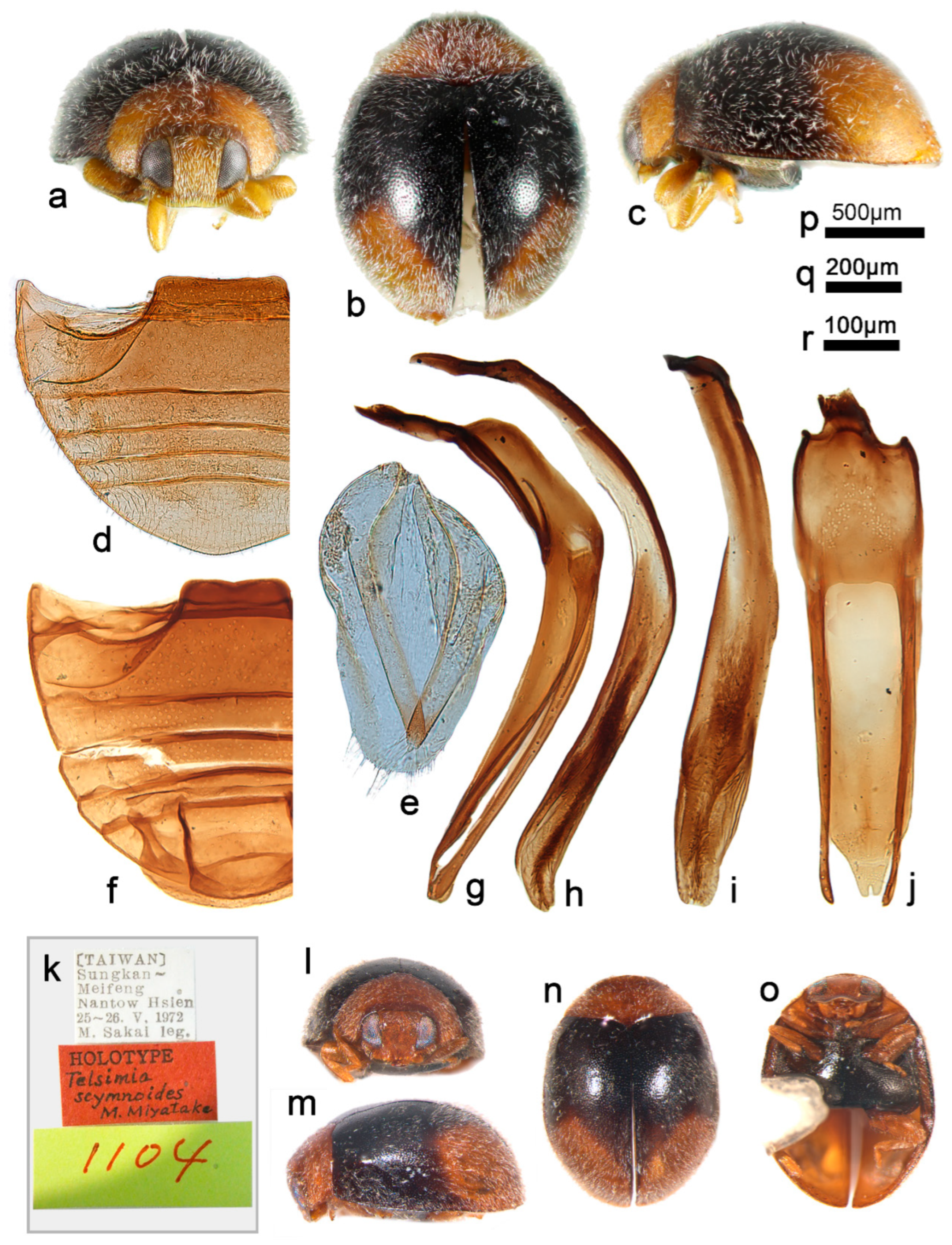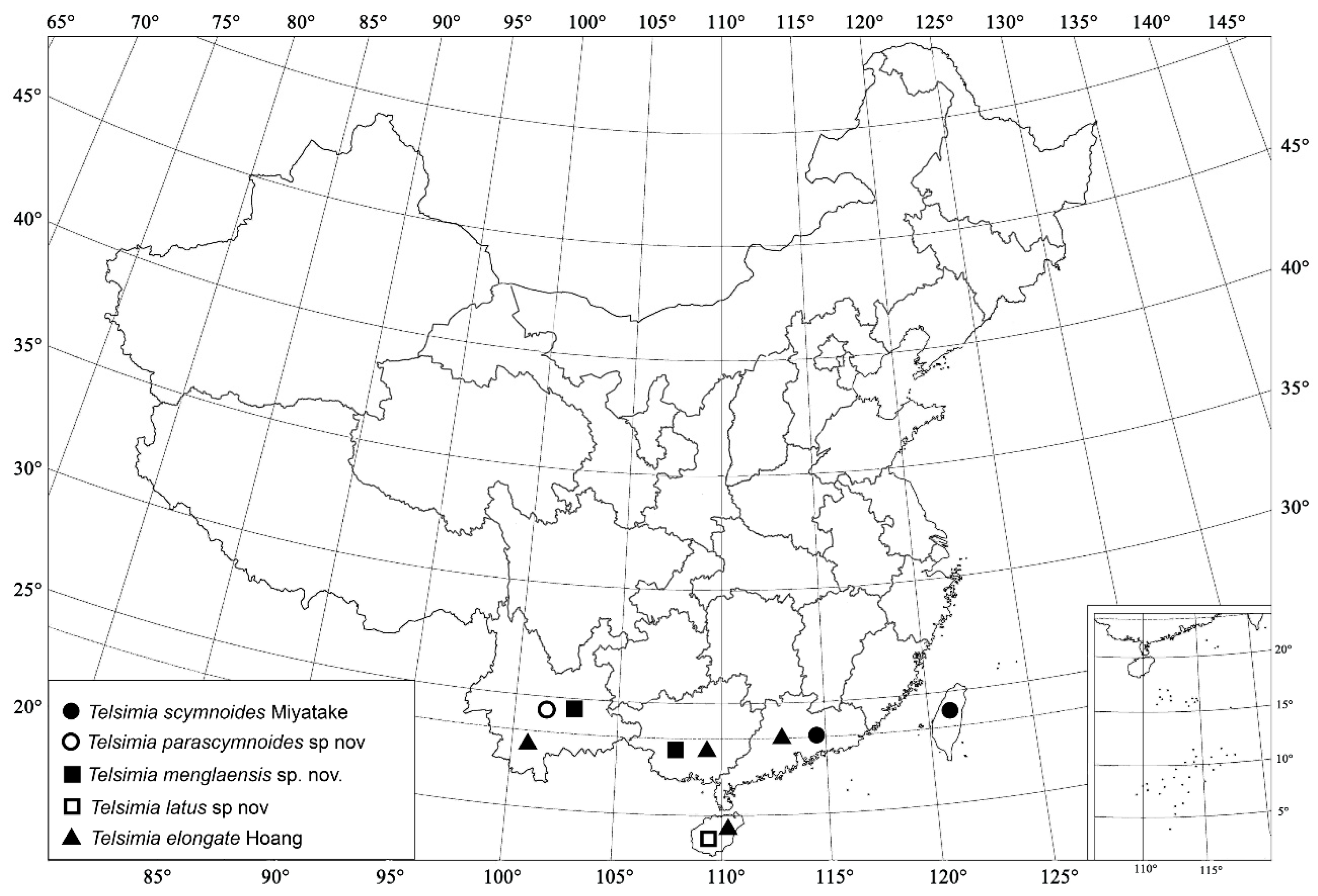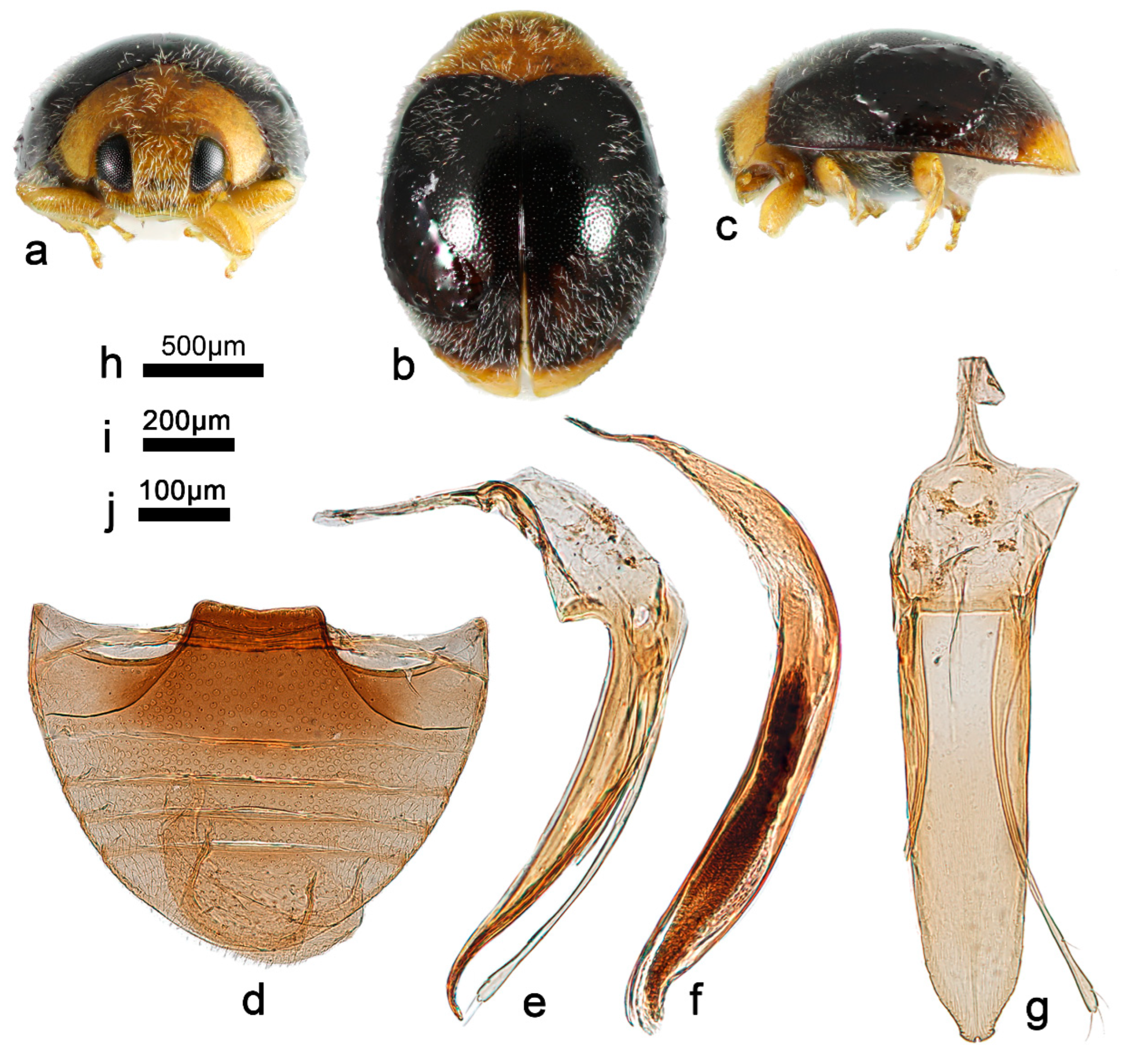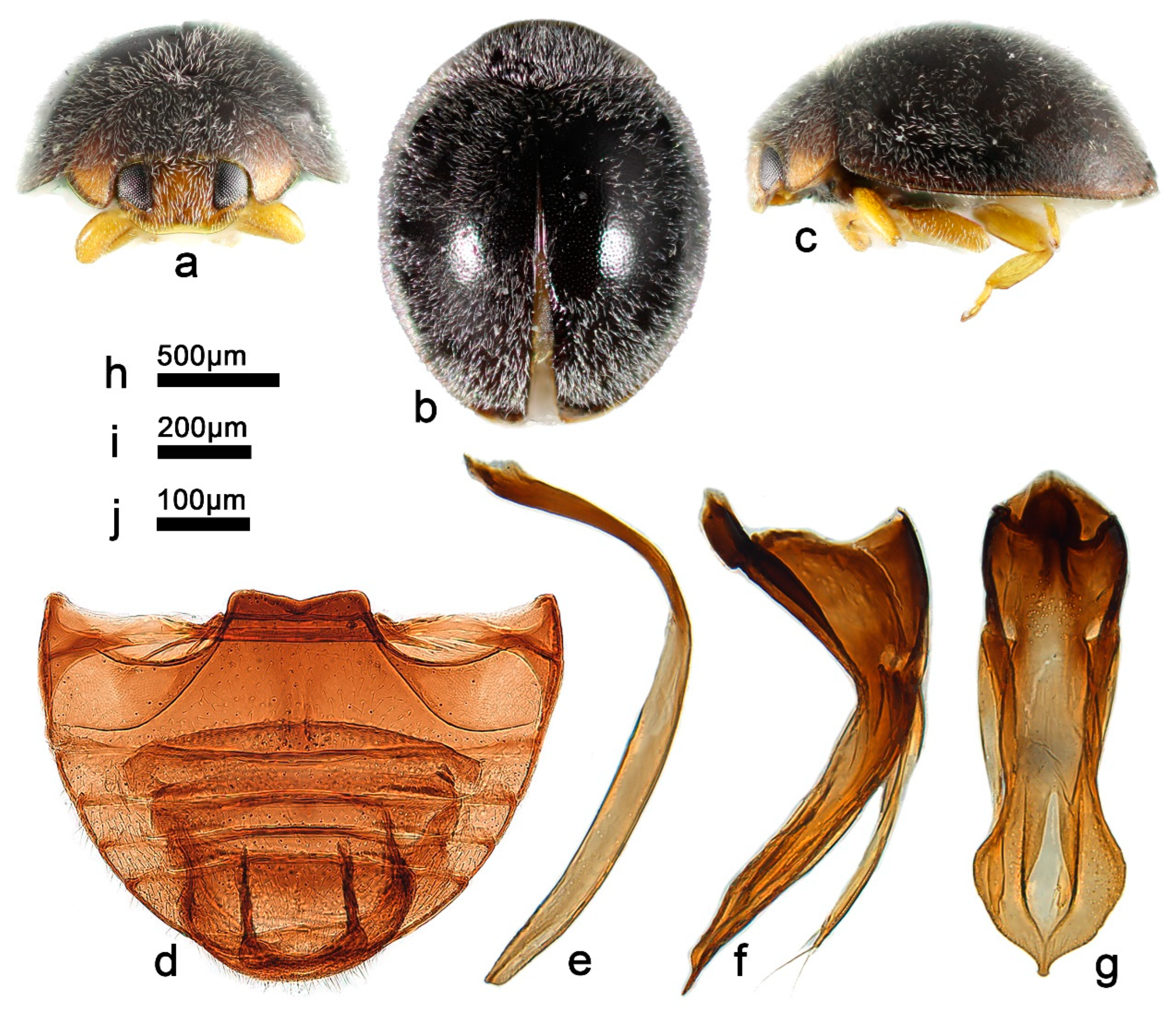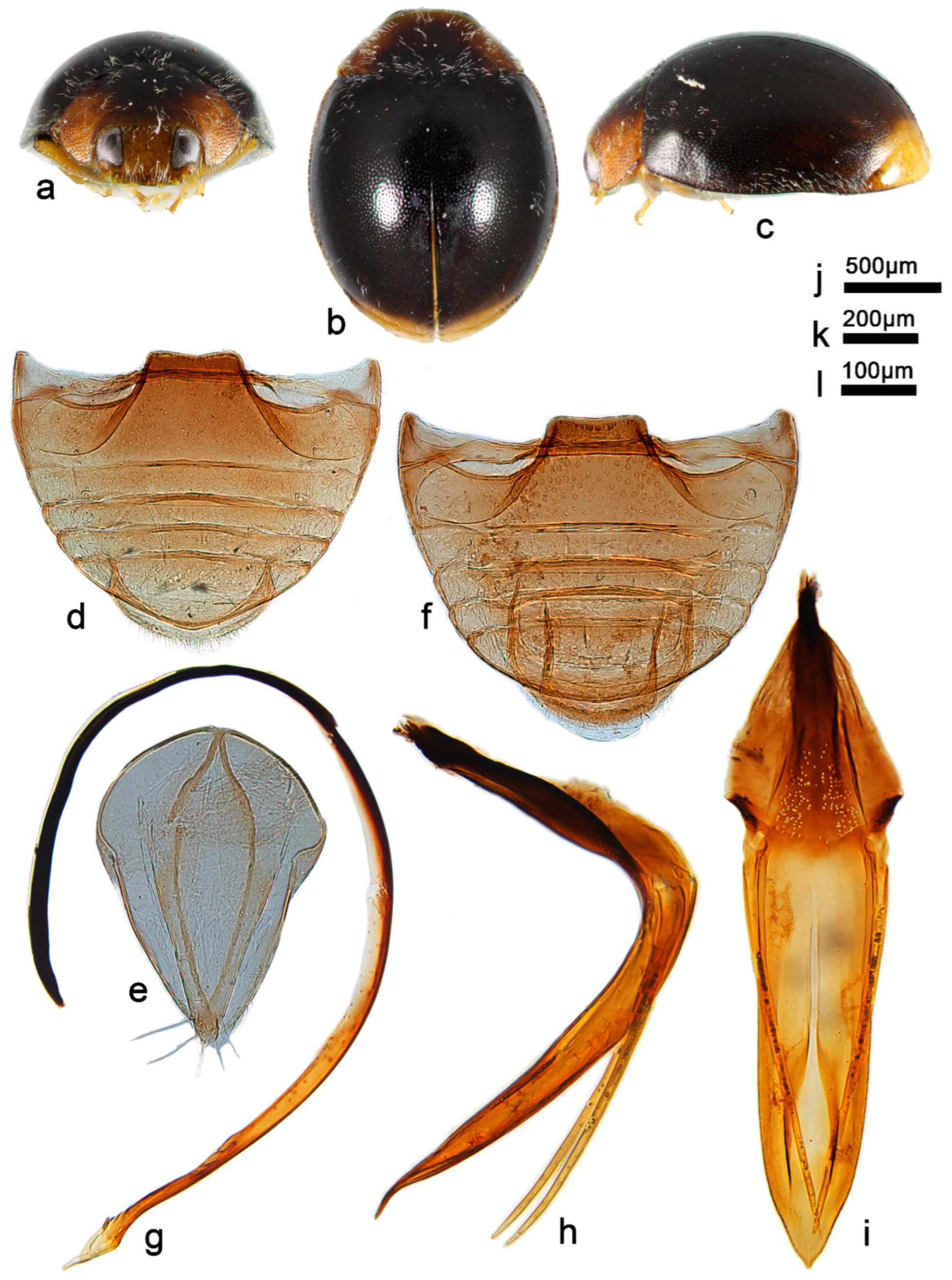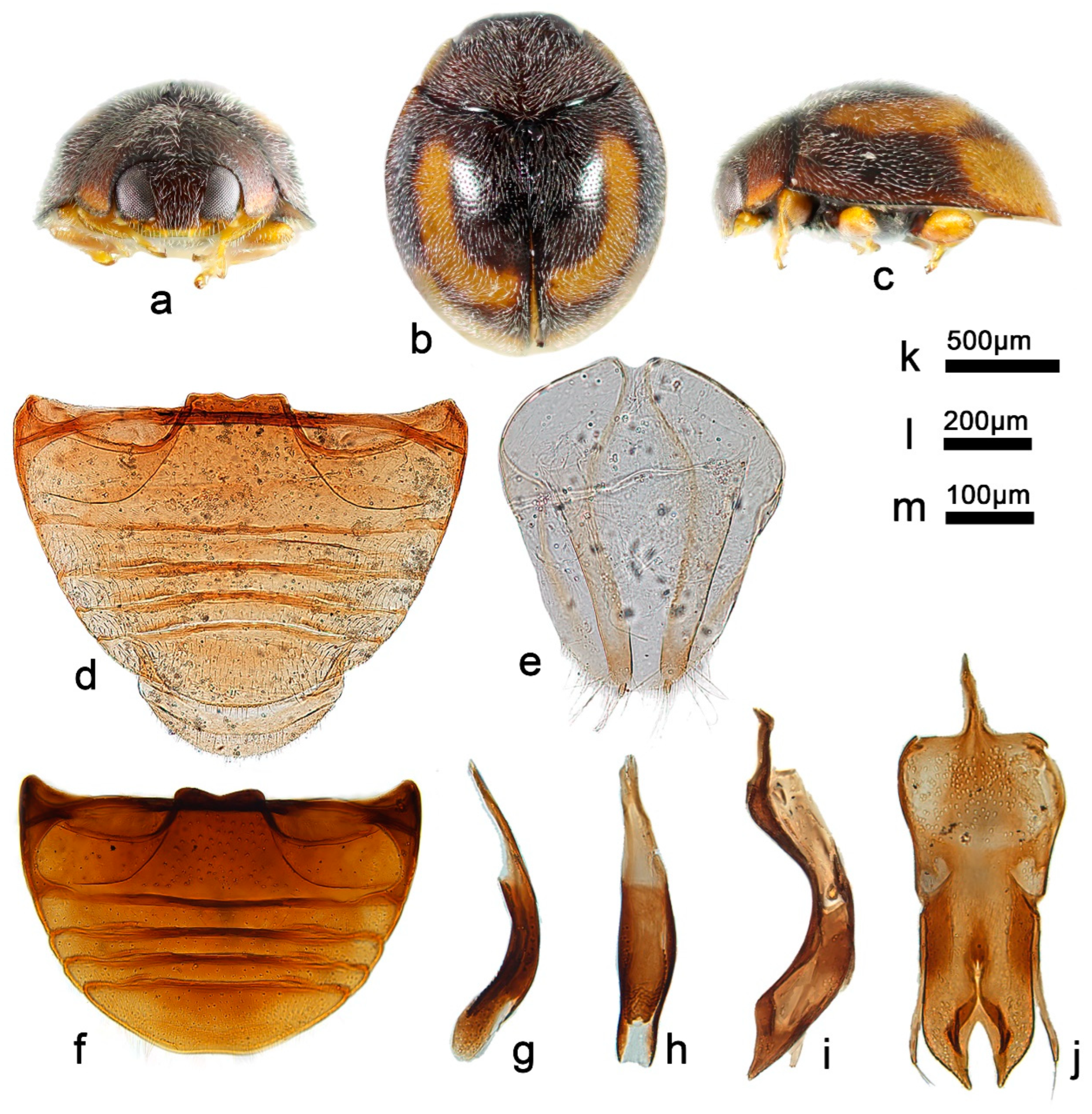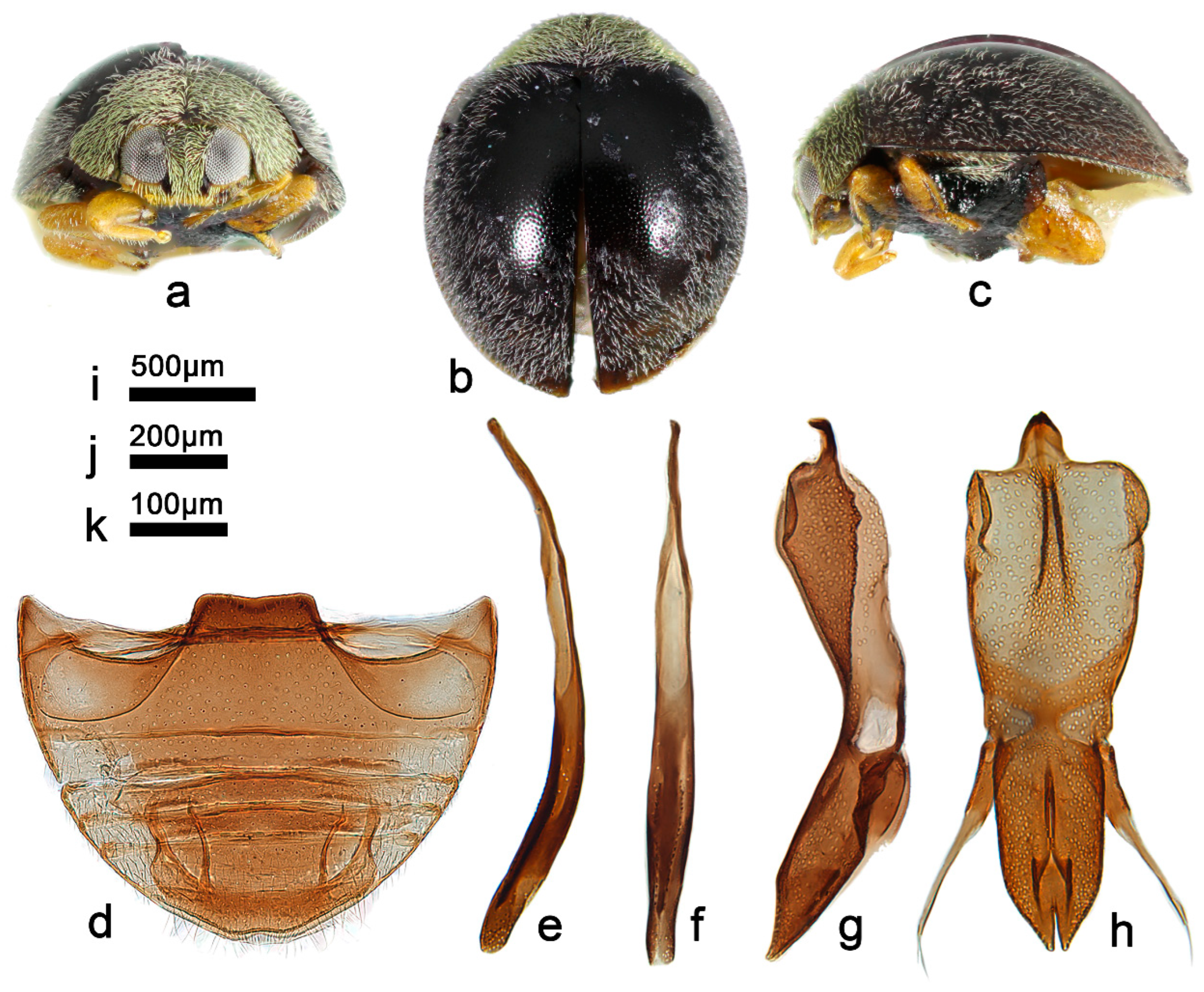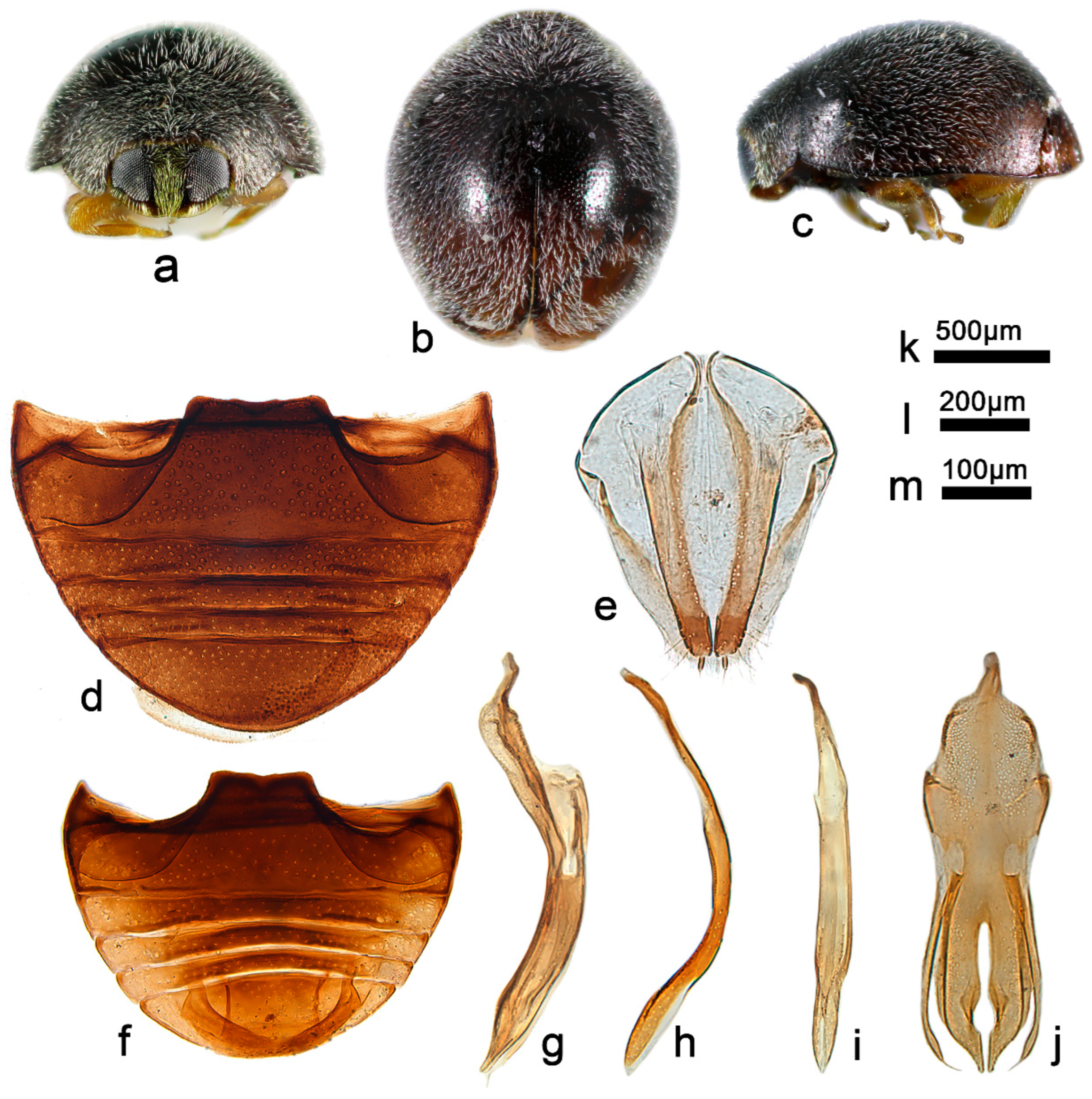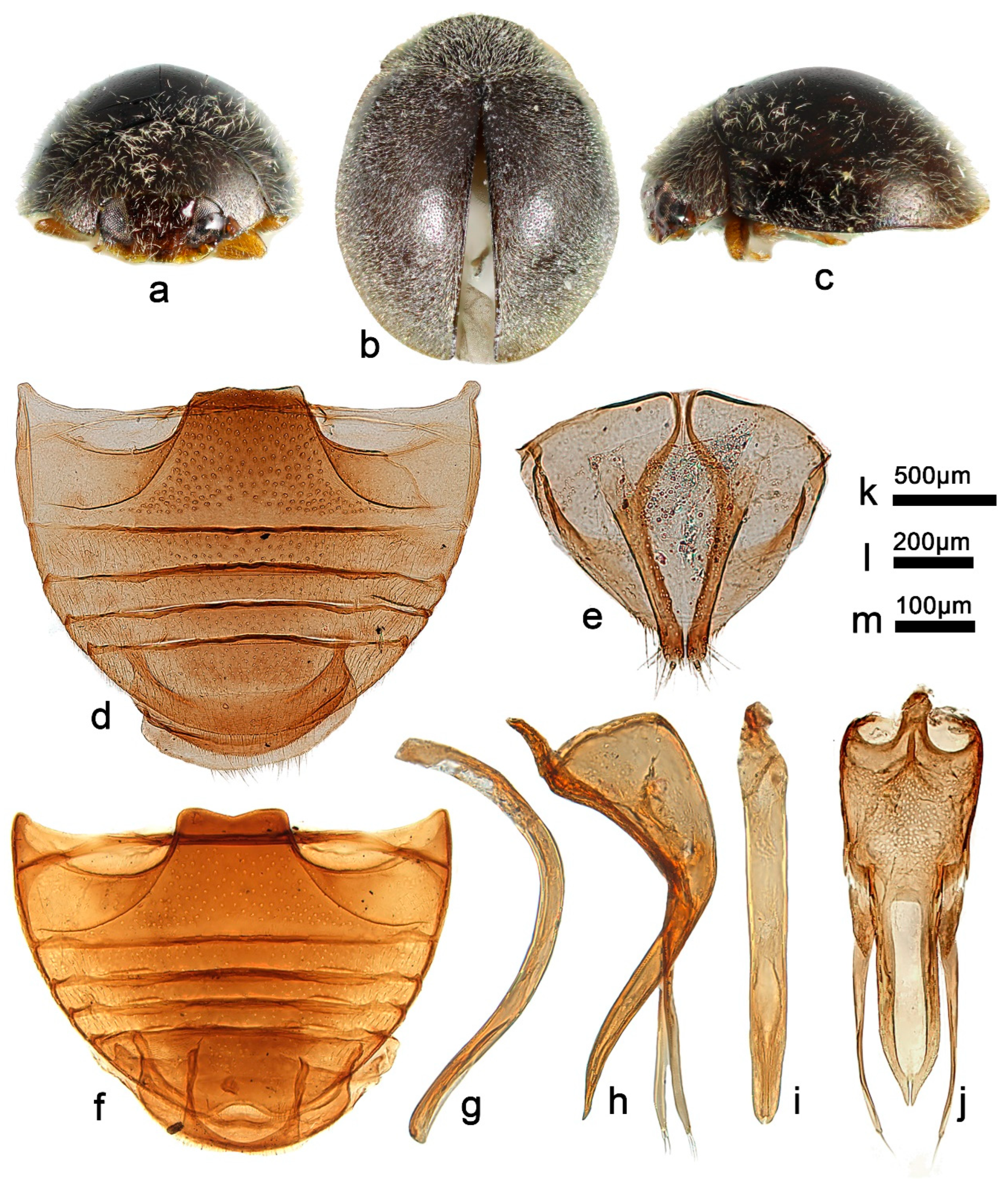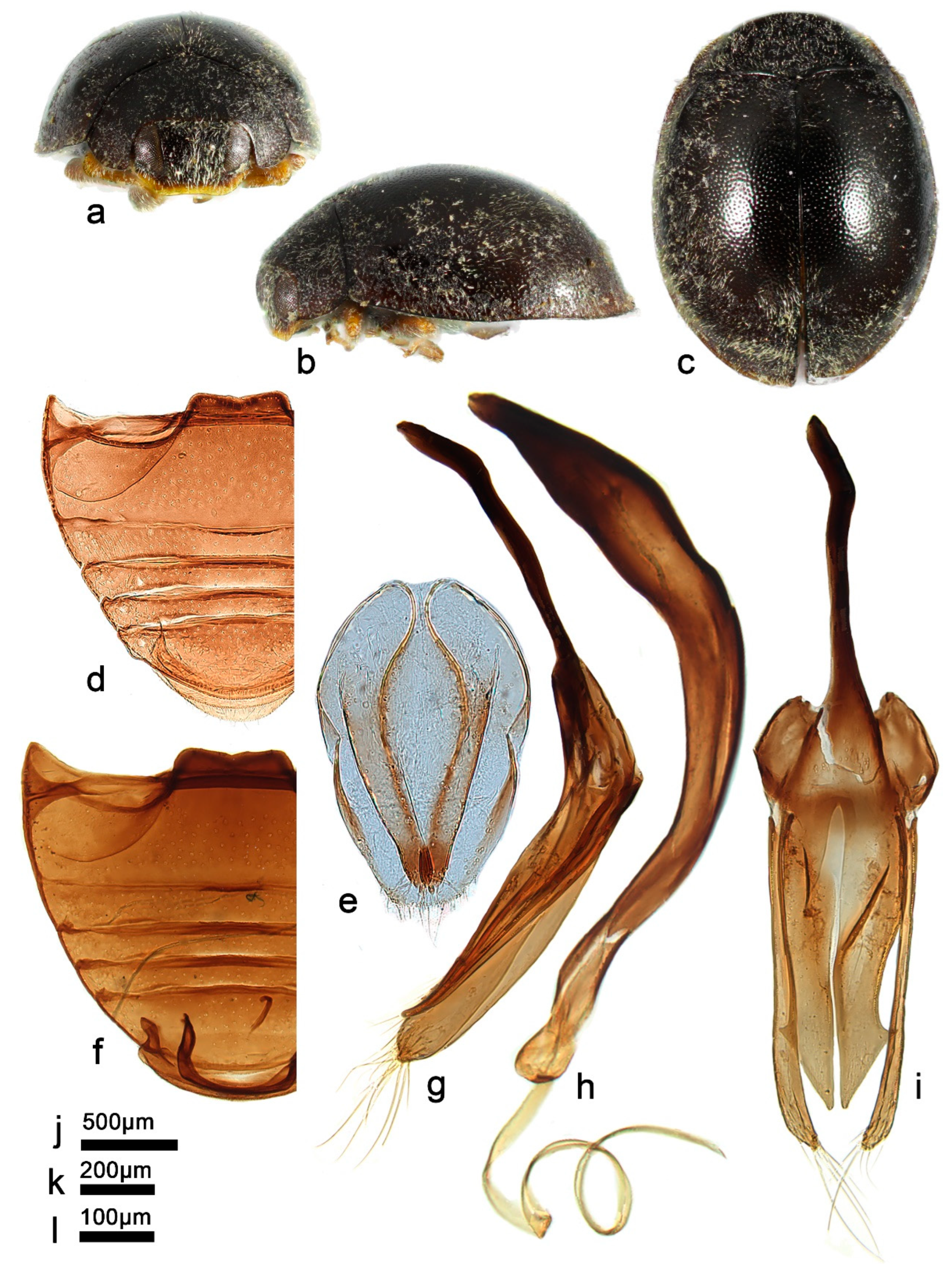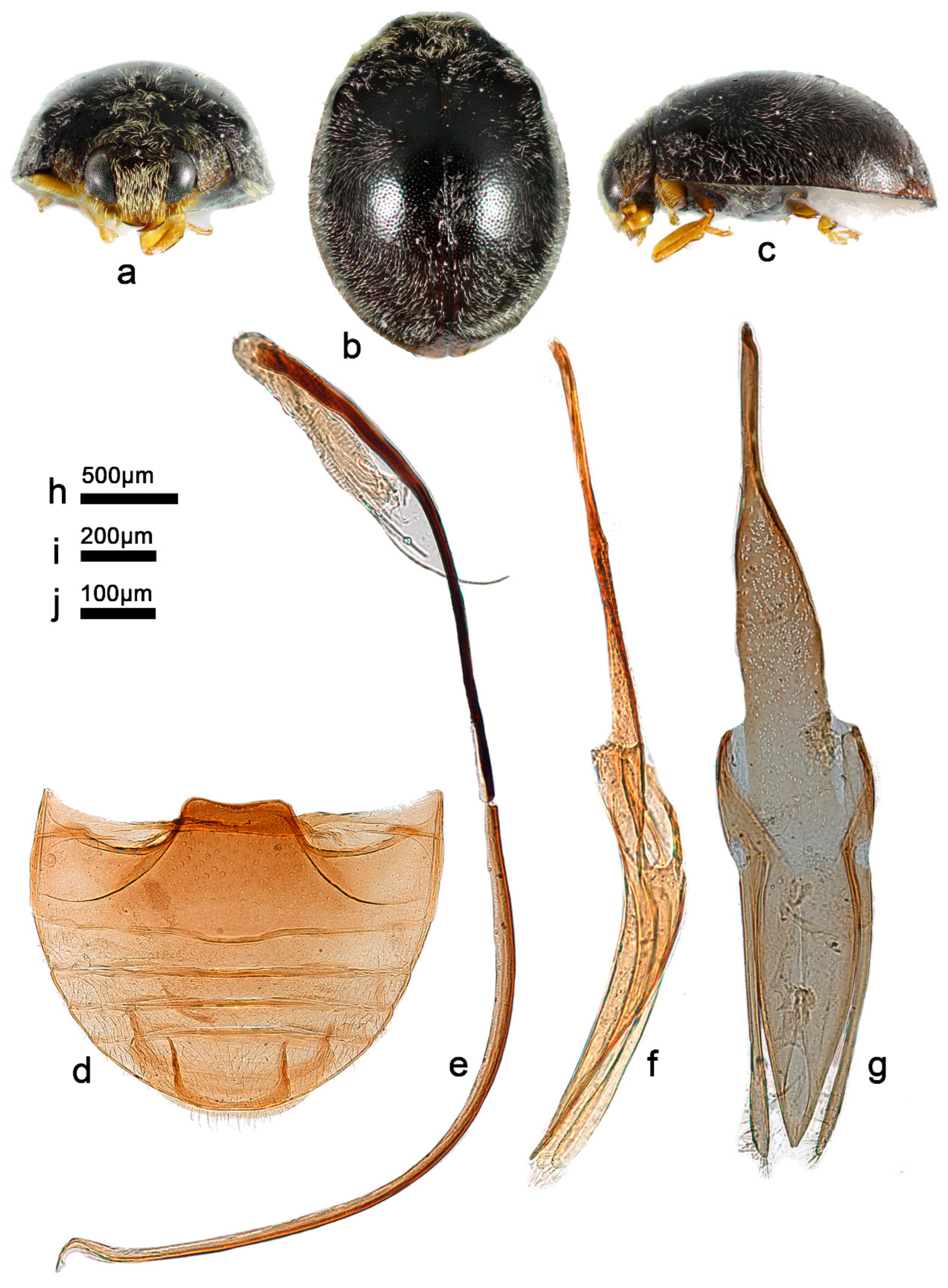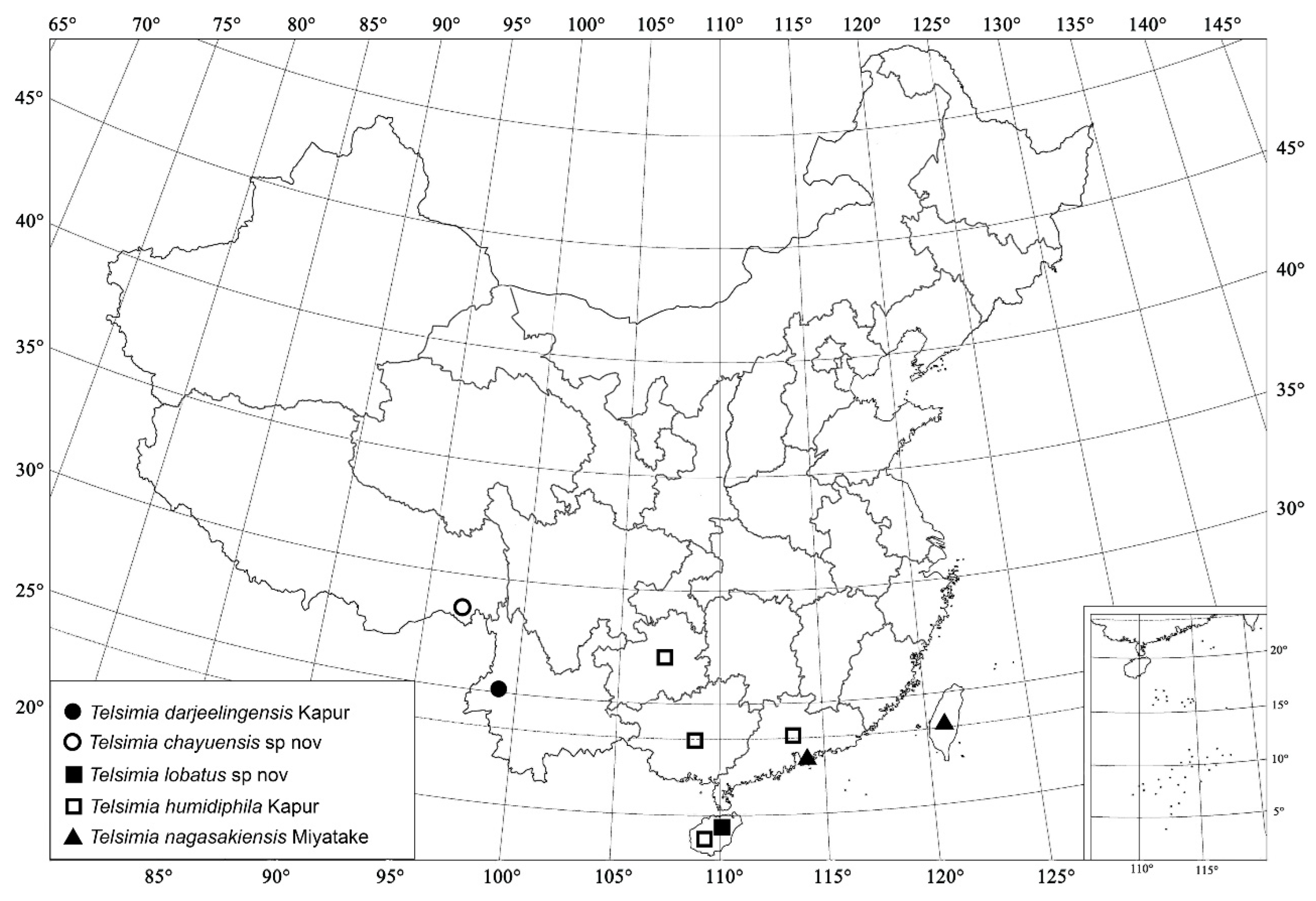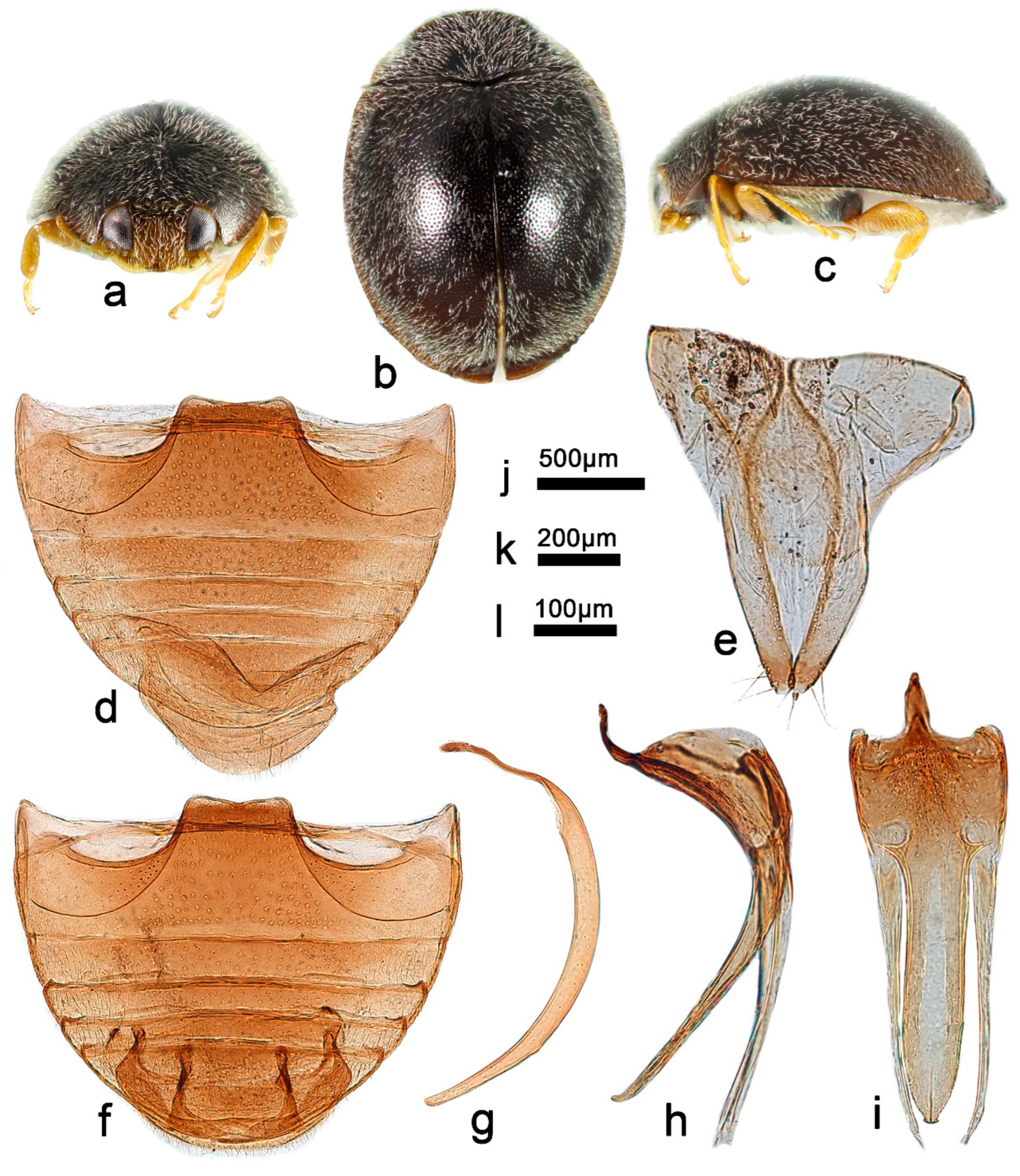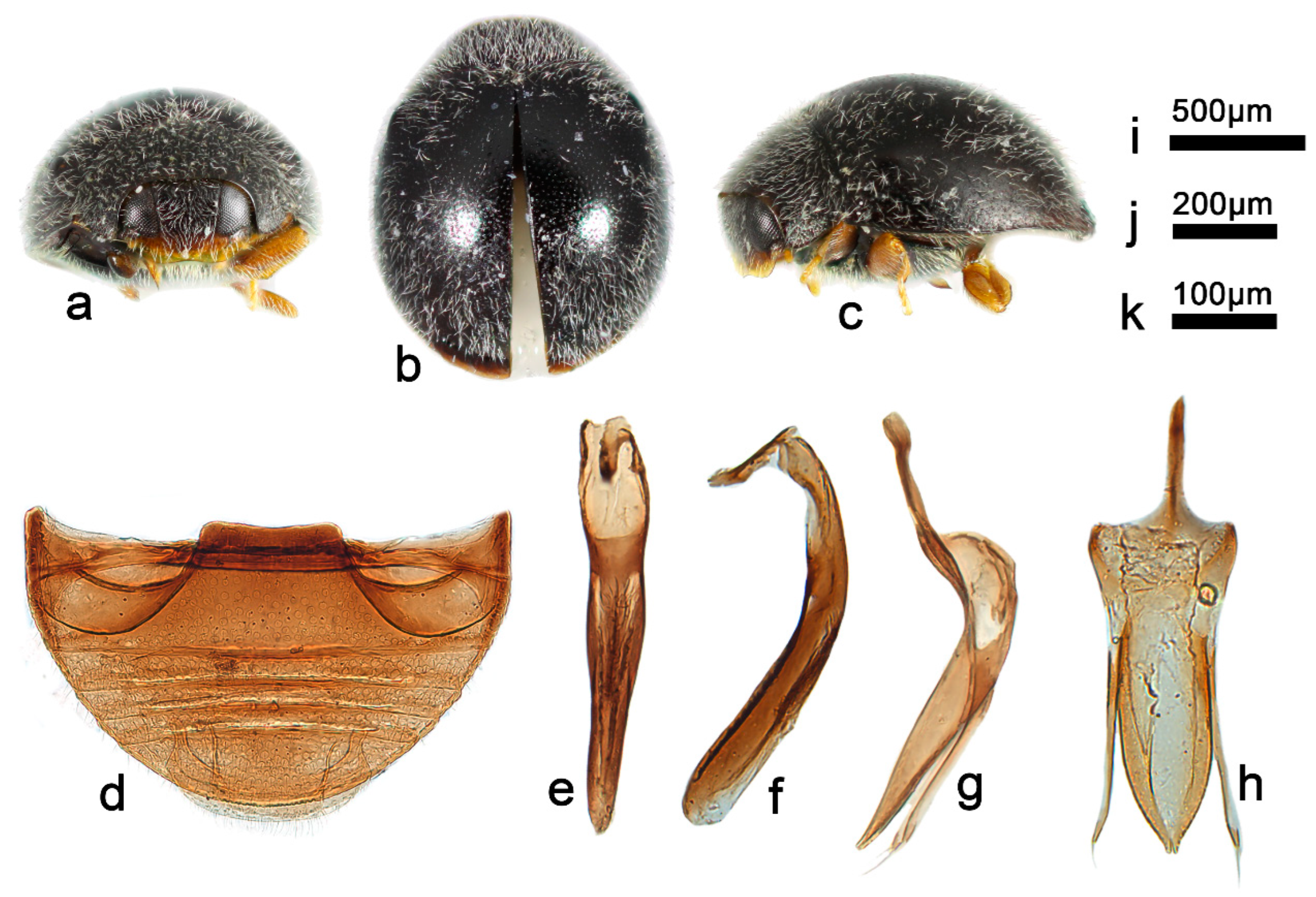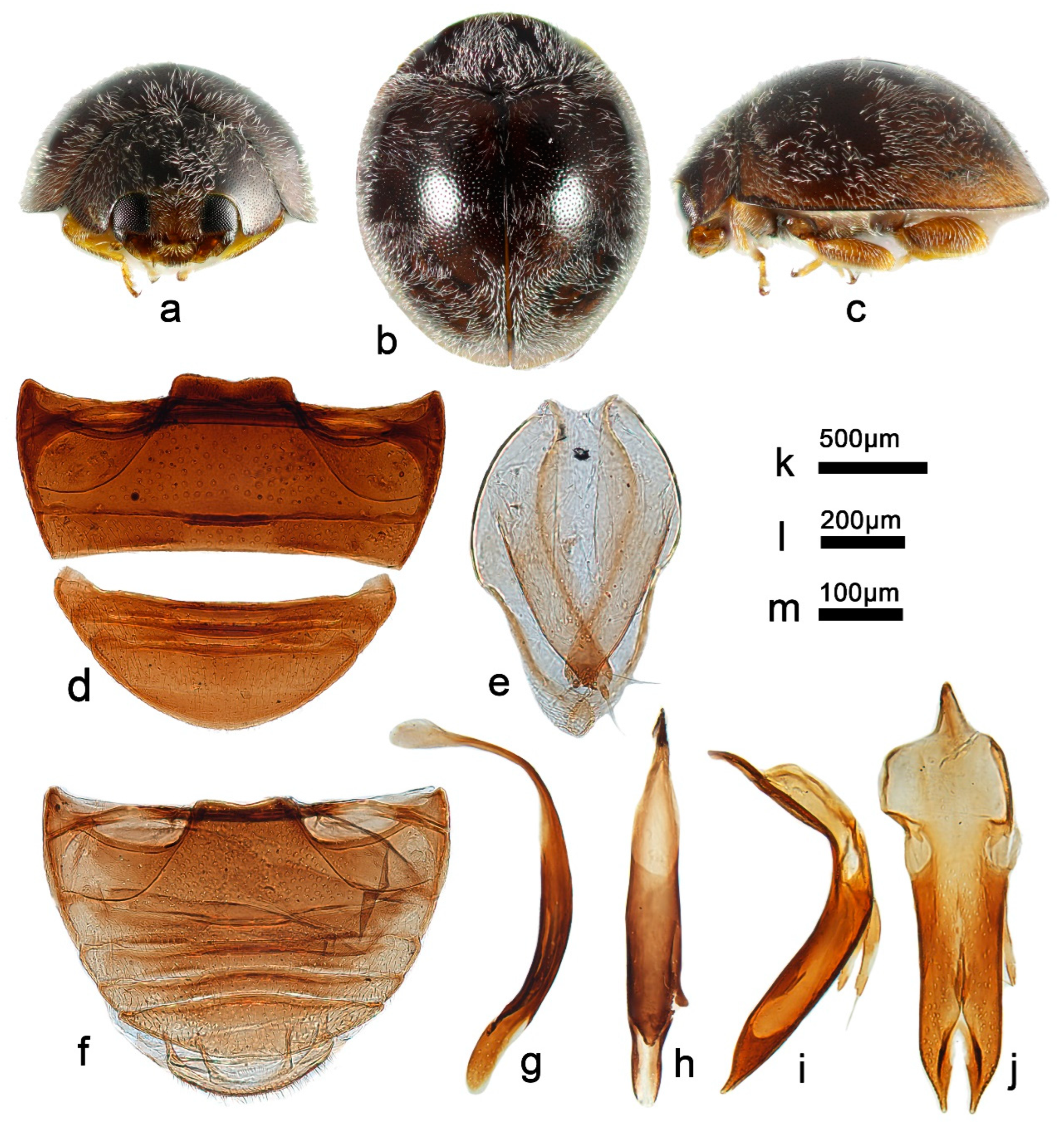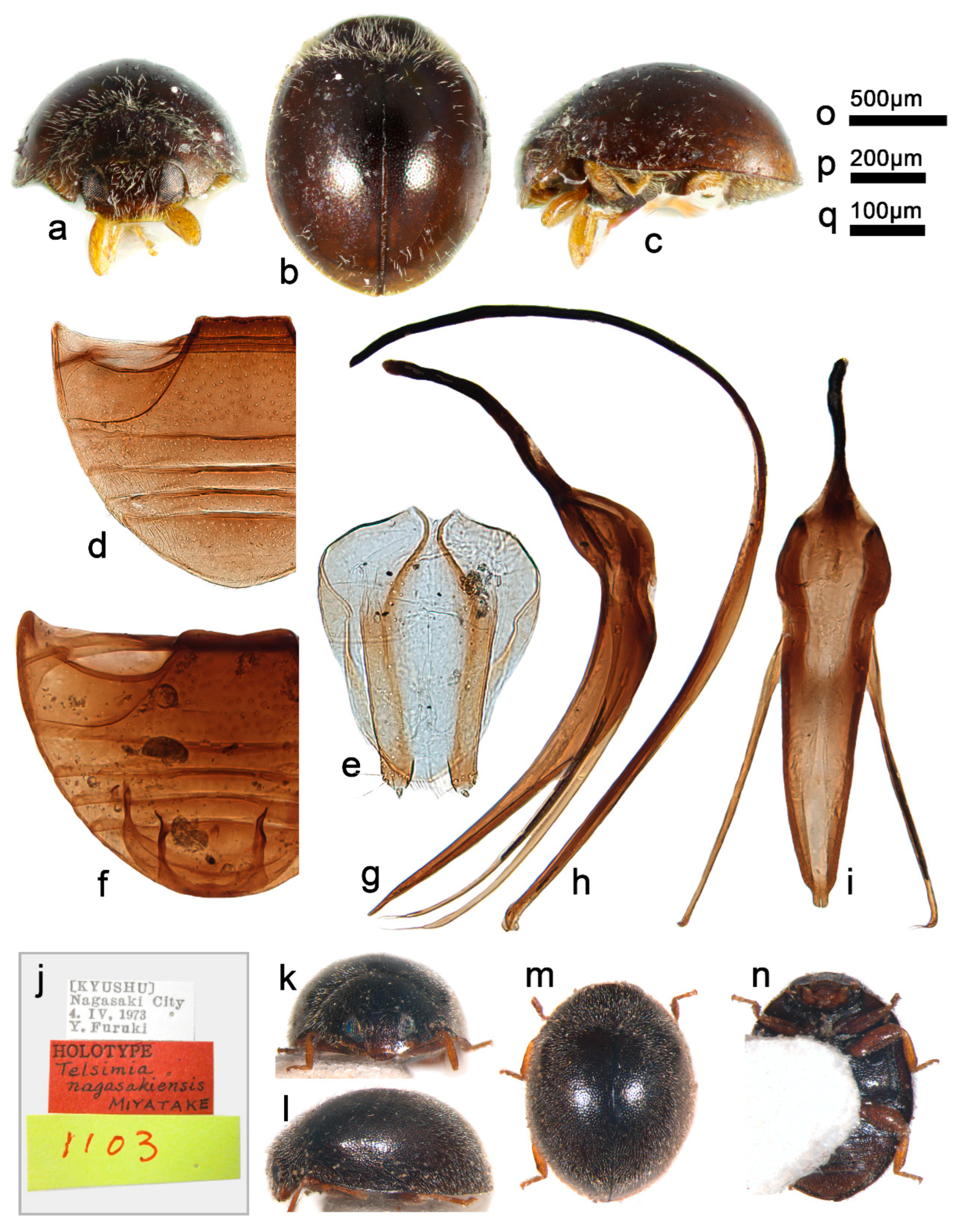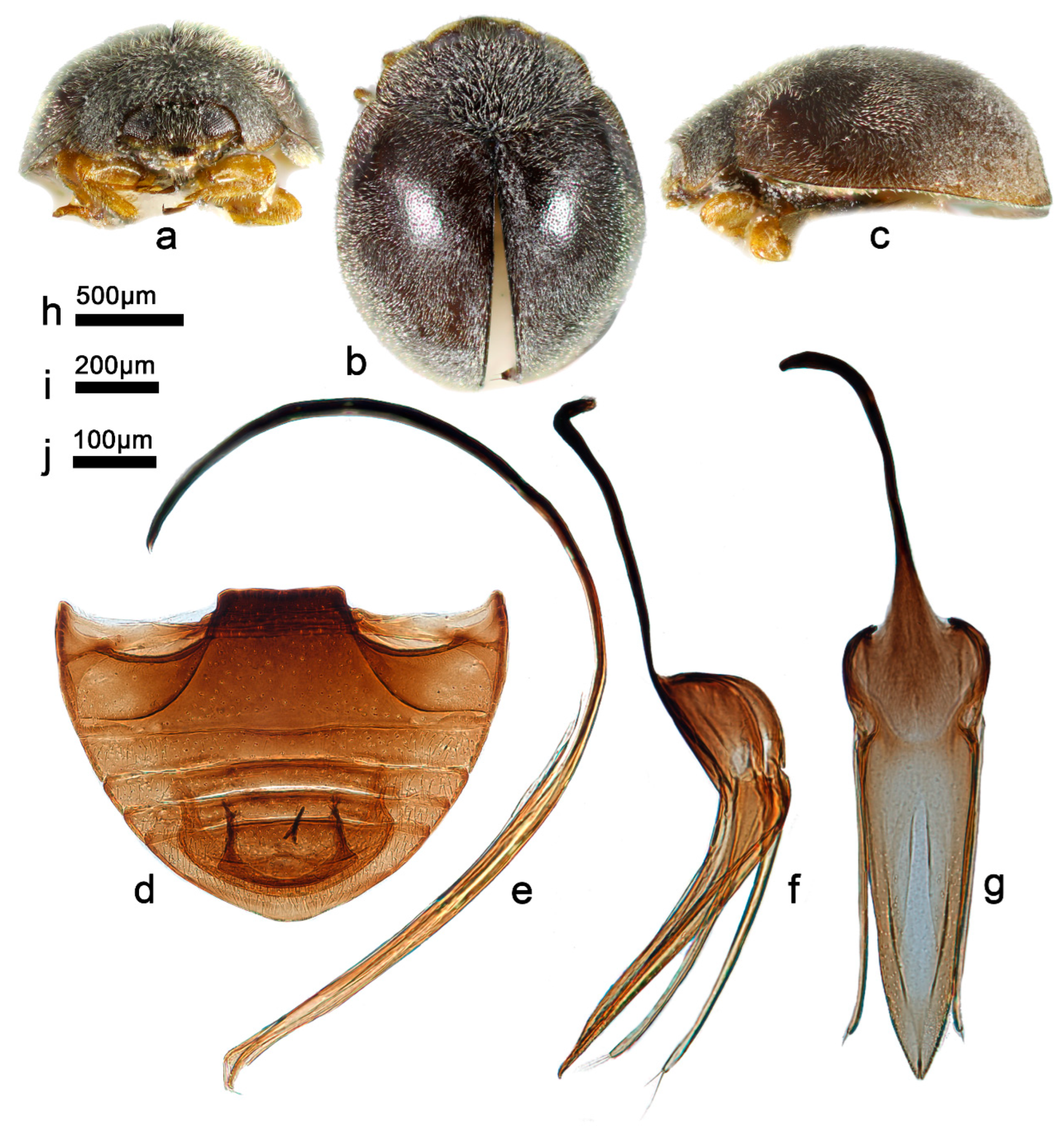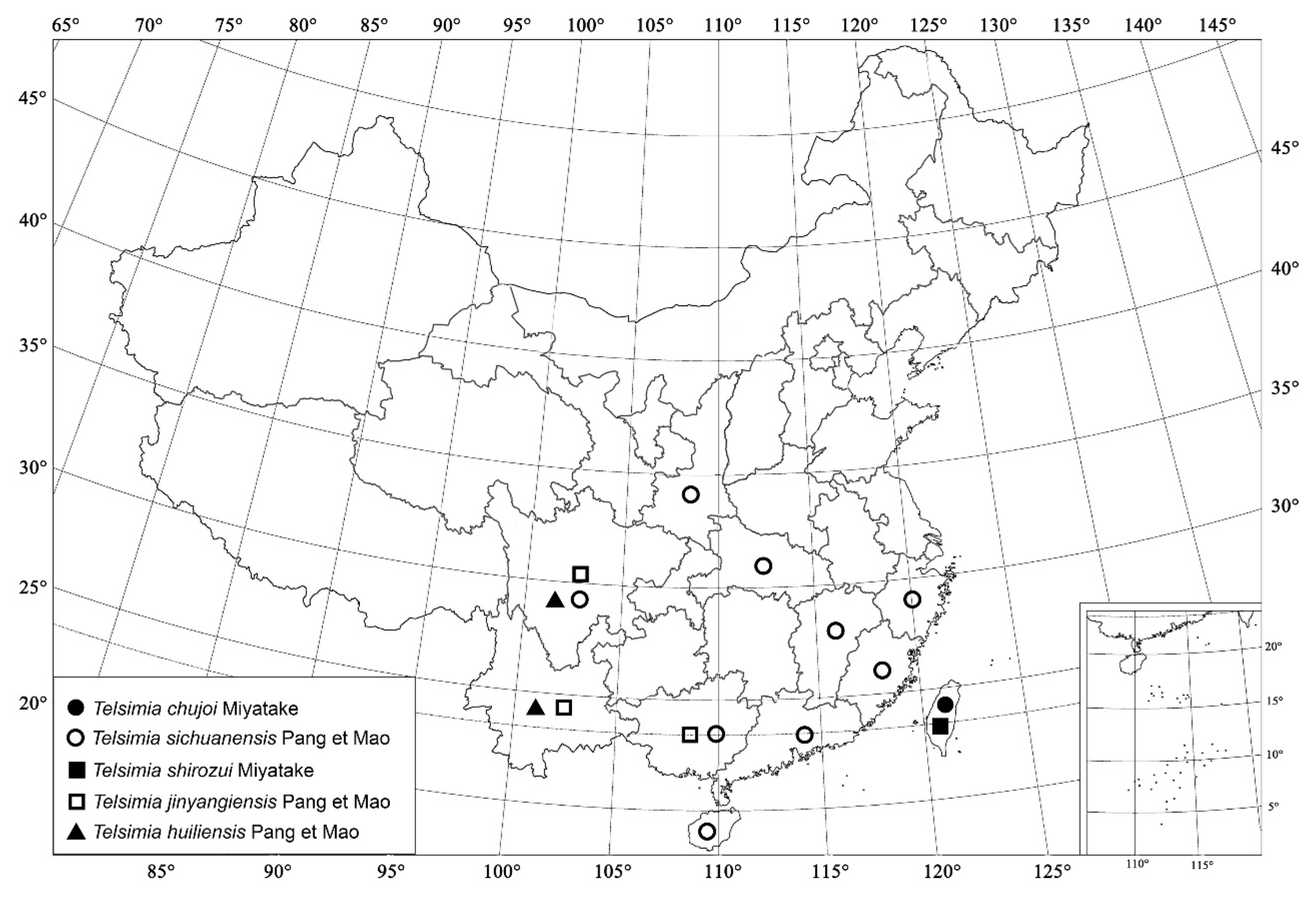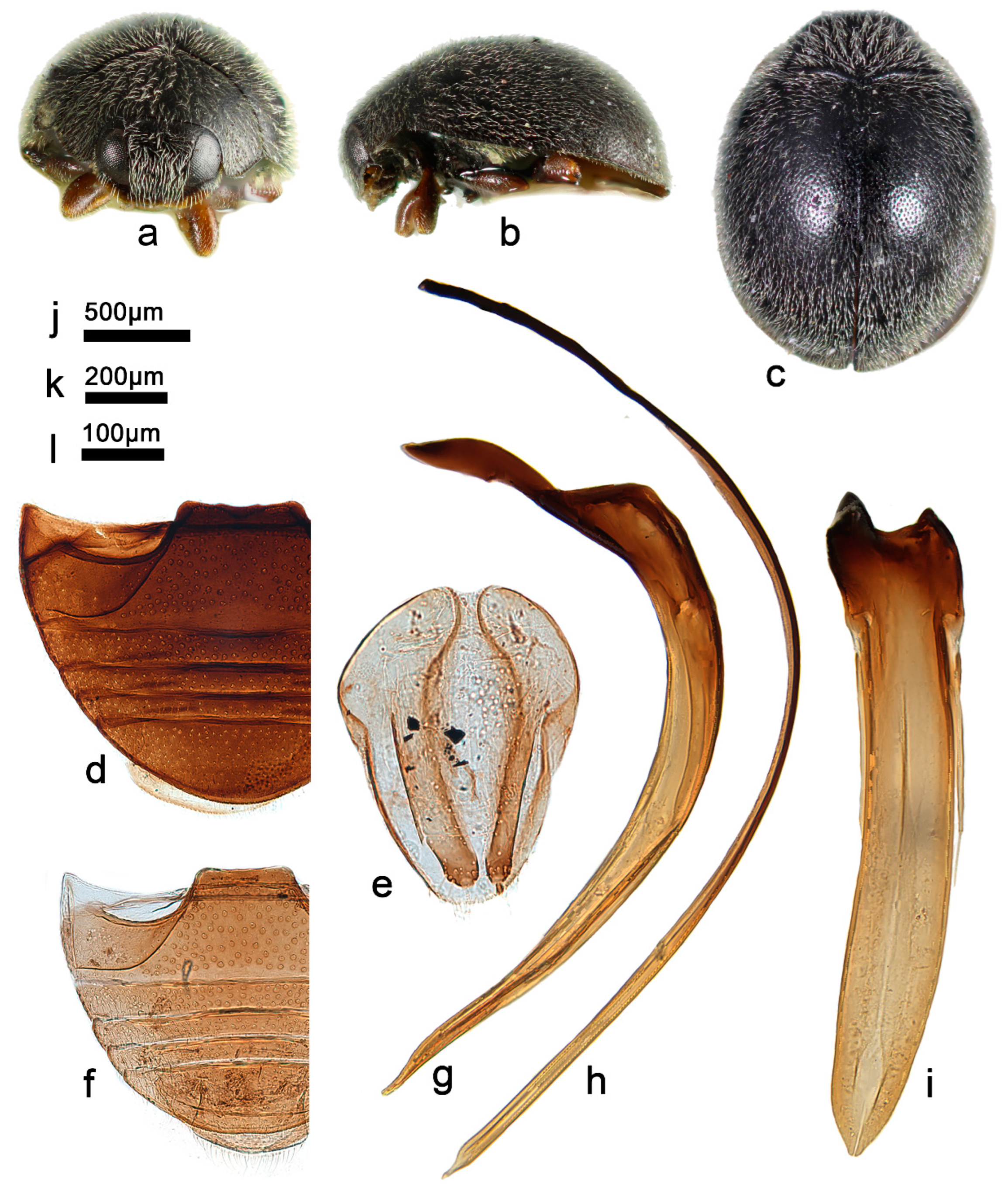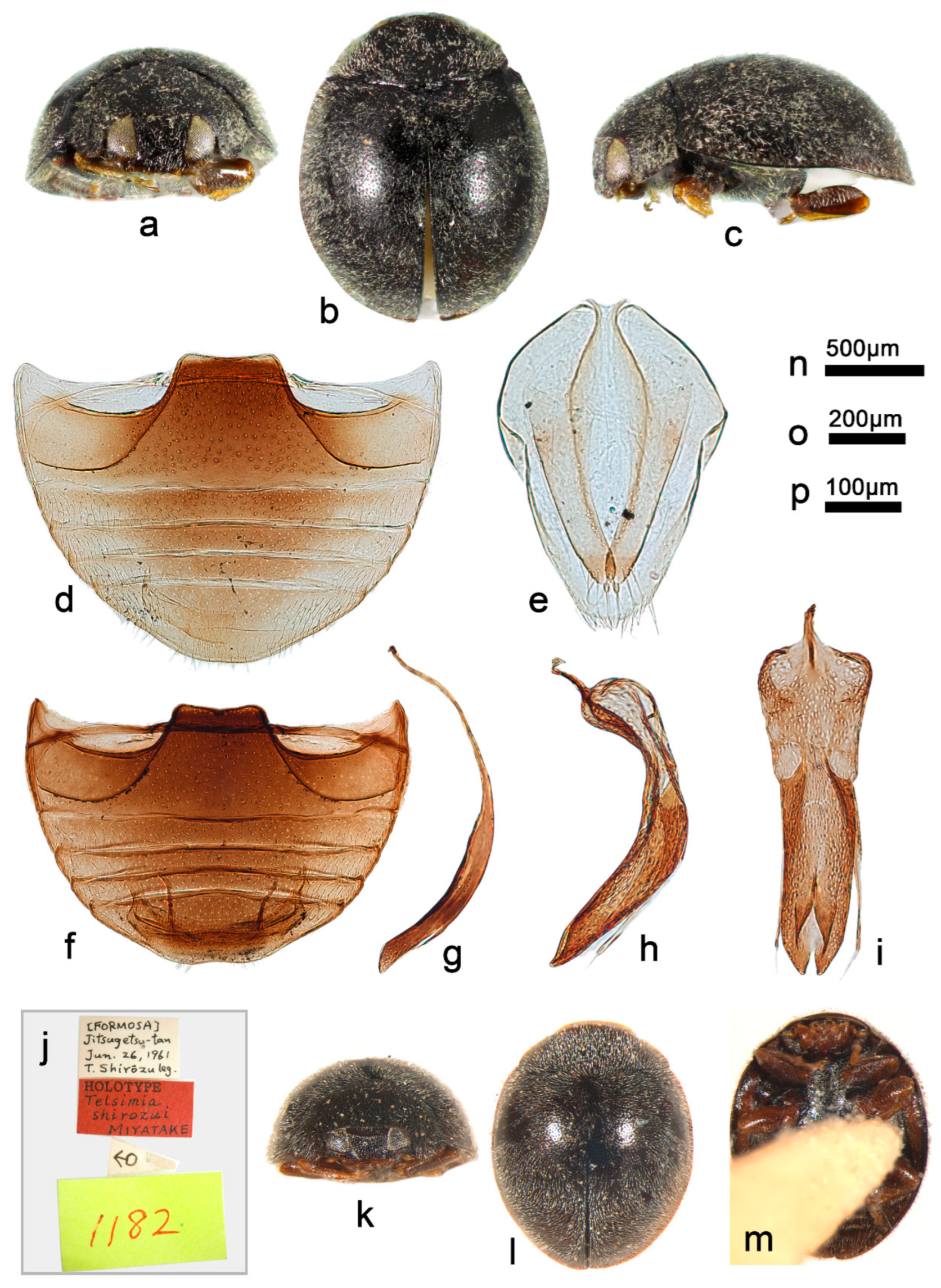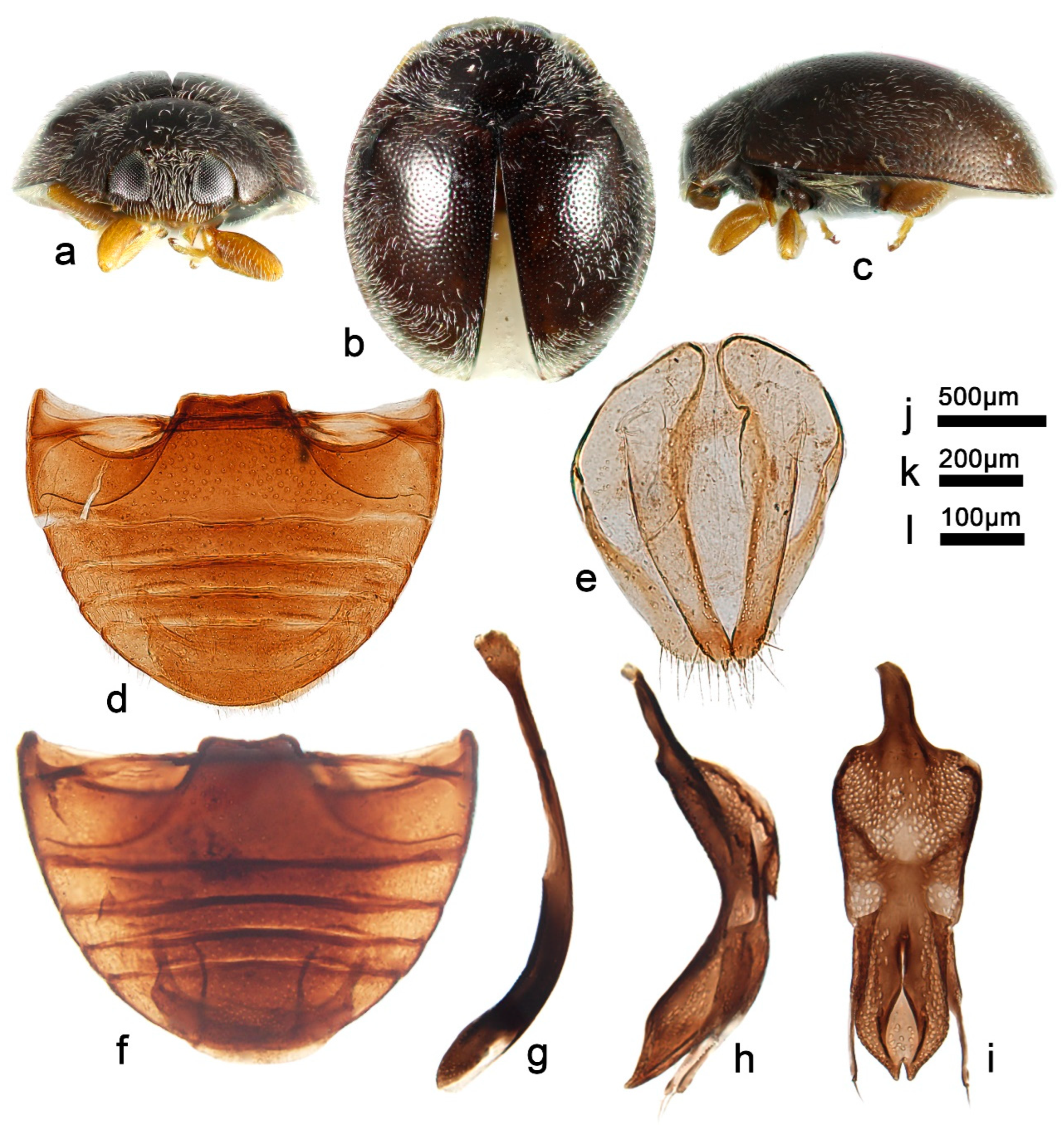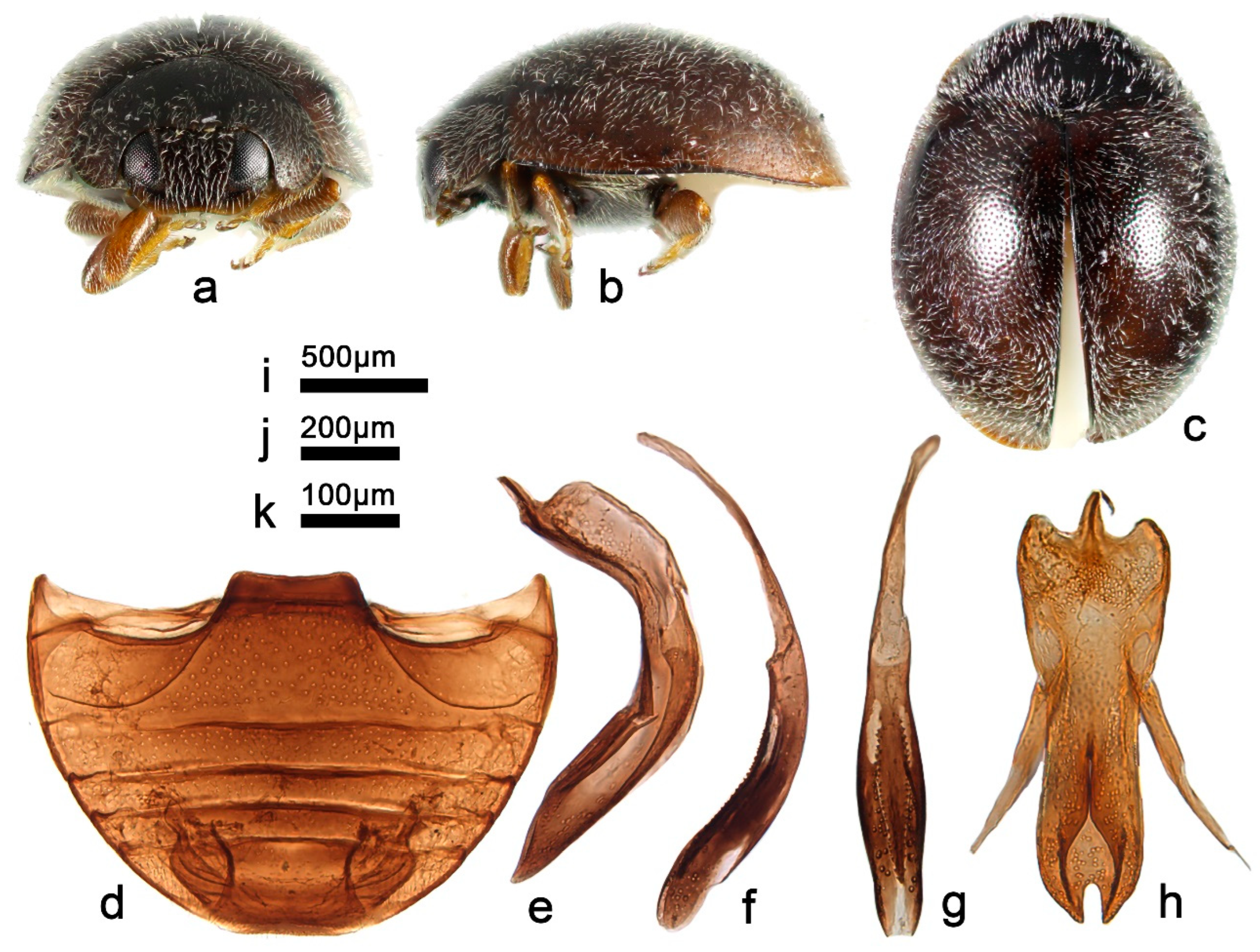3.1. Taxonomy
Telsimia scymnoides Miyatake, 1978: 15 [
23]; Yu, 1995: 141 [
35]; Ren et al., 2009: 152 [
39].
Diagnosis. This species can be easily distinguished from other
Telsimia species by its unique coloration: head and pronotum entirely brownish yellow; elytra black, each elytron with a large, oblique, oval, brownish yellow spot at apical half, reaching lateral margin, suture, and apex (
Figure 1a–c). It can also be diagnosed by its male genitalia: in ventral view, base of penis guide is nearly the same width as phallobase, slightly convergent to apical one-fifth, then suddenly narrowing to a bifid apex (
Figure 1j).
Material examined (16). Holotype: [Taiwan], Sungkan Meifeng, Nantow Hsien, 25-26.V.1972, M. Sakai leg. //Holotype, Telsimia scymnoides M. Miyatake//1104 (♂, EUMJ). Other materials: China: Guangdong Prov.: Shimentai National Nature Reserve: 9♂2♀, Huangdong Village, 30.X.2004, Wang XM leg; 3♀, Wulangzhang Village, 8.X.2004, Wang XM leg; Taiwan Prov.: 1♂, Jiayi County, Fenchihu Lake, 1400m, 9.IV.1977, J. Klapperich leg, SCAUI11025.
Distribution. China: Guangdong, Taiwan.
Biology. Unknown.
Etymology. The specific epithet refers to its general appearance and penis guide closely resembling T. scymnoides Miyatake.
Diagnosis. In male genital structure, this species is most closely related to
T. scymnoides but can be easily distinguished from the latter by detailed characteristics of penis guide: in ventral view, penis guide slightly convergent to apical one-sixth, then relatively smoothly narrowing to the apex, which is protruding and arcuate, with a tiny notch at middle (
Figure 2g), while in
T. scymnoides, penis guide slightly convergent to apical one-fifth, then suddenly narrowing to a bifid apex (
Figure 1j).
Description. TL: 1.70 mm, TW: 1.30 mm, TH: 0.80 mm, PL: 0.48 mm, PW: 0.90 mm, HW: 0.56 mm, ID: 0.24 mm, TL/TW: 1.31, PL/PW: 0.53, EL/EW: 1.00, HW/PW: 0.62, PW/EW: 0.69; ID/HW: 0.43.
Body oblong oval, convex, broadest at or very slightly behind middle; elytra entirely black except apical part brownish yellow; pronotum, head and clypeus brownish yellow (
Figure 3a–c); mesoventrite and metaventrite dark brown; elytral epipleuron brownish yellow; mouthpart, prothoracic hypomeron, prosternum, and legs brownish yellow. Head between eyes 0.43 times the width of head; pubescence dense, appressed, and silver-white. Pronotum approximately twice as broad as median length; anterior border arcuate medially, distance between anterior angles 0.65 times that between posterior angles, lateral borders arcuately convergent from obtuse posterior to briefly rounded anterior angles; pubescence sparse, suberect, and silver-white. Elytra slightly longer than greatest combined breadth; external margins not explanate to borders; pubescence sparse, suberect, and silver-white. Abdominal postcoxal lines of ventrite 1 slightly recurved, punctures between coxae large and dense; ventrite 5 in midline as long as ventrites 2–4 together, apical border evenly arcuate in male (
Figure 3d).
Male genitalia: Penis robust (
Figure 3f), in lateral view, as long as tegmen, basal one-third gradually narrowing from the middle to distal end, which is thread-like; apical one-fifth gradually narrowing to a rounded apex. In lateral view of penis guide (
Figure 3e), tegminal strut short, nearly one-fourth the length of tegmen; penis guide slender, gradually narrowing to a pointed apex, bent outward; parameres slender, slightly shorter than penis guide. In ventral view of penis guide (
Figure 3g), phallobase nearly trapezoid, the top 1.5 times the length of the bottom; base of penis guide nearly the same width as base of phallobase, penis guide slightly convergent to apical one-sixth, then relatively smoothly narrowing to the apex, which is protruding and arcuate, with a tiny notch at middle.
Female genitalia: Unknown.
Types. Holotype: ♂, China: Yunnan Prov.: Mengla County, Yaoqu Town, ca. 700 m, 7–8.V.2009, Ren SX et al. leg, SCAU(E)16766.
Distribution. China: Yunnan.
Biology. Unknown.
Etymology. The specific name refers to the locality of its holotype.
Diagnosis. In external appearance, it is similar to
T.
parascymnoides sp. nov., with the head, pronotum, and elytra terminal brownish yellow (
Figure 4a–c), but can be easily distinguished from the latter by the male genitalia (
Figure 3e–g and
Figure 4g–i). The male genitalia are also closely related to
T.
shirozui but can be distinguished from the latter by the following characteristics: in ventral view of tegmen, base of phallobase half the width of proximal end, apical emargination of penis guide larger, inverted U shape; in
T.
shirozui, base of phallobase slightly narrower than proximal end, apical emargination smaller, inverted V shape. In lateral view of tegmen, penis guide thick, nearly parallel for the basal two-thirds, apical part sharper; in
T.
shirozui, penis guide relatively thinner, gradually narrowing to apical one-fourth, apical part blunt.
Description. TL: 1.60–1.80 mm, TW: 1.24–1.44 mm, TH: 0.82–0.90 mm, PL: 0.44–0.50 mm, PW: 0.90–1.02 mm, HW: 0.56–0.64 mm, ID: 0.22–0.28 mm, TL/TW: 1.25–1.29, PL/PW: 0.49–0.51, EL/EW: 0.97–1.00, HW/PW: 0.60–0.63, PW/EW: 0.71–0.75, ID/HW: 0.39–0.44.
Body oval, convex, broadest at middle; elytra black to crater brown, except apical part brownish yellow; pronotum, head and clypeus brownish yellow; mesoventrite and metaventrite dark brown; mouthparts, prothoracic hypomeron, prosternum, elytral epipleuron, and legs brownish yellow. Head between eyes nearly 0.4 times the width of head; pubescence dense, appressed, and silver-white. Pronotum approximately twice as broad as median length; anterior border arcuate medially, distance between anterior angles 0.6 times that between posterior angles, lateral borders arcuately convergent from obtuse posterior to briefly rounded anterior angles; pubescence sparse, suberect, and silver-white. Elytra slightly shorter than greatest combined breadth; external margins not explanate to borders; pubescence sparse, suberect, and silver-white. Abdominal postcoxal lines of ventrite 1 not recurved, punctures between coxae large and dense; ventrite 5 in midline as long as ventrites 2–4 together, apical border slightly notched medially in male and arcuate in female (
Figure 4d,f).
Male genitalia: Penis, in lateral view (
Figure 4g), as long as the tegmen, basal half distinctly narrower, apical one-fifth gradually narrowing to rounded apex. In lateral view of tegmen (
Figure 4h), tegminal strut short, nearly one-sixth the length of tegmen; penis guide thick, thickness almost equals the width of penis guide in ventral view, nearly parallel for the basal two-thirds, apical part sharper; parameres distinctly shorter than penis guide. In ventral view of tegmen (
Figure 4i), the base of phallobase half as wide as the proximal end, penis guide nearly parallel from base to apical one-fifth, then gradually narrowing to a bifid apex, the apical emargination larger, inverted U shape.
Female genitalia: As shown in
Figure 4e.
Types (4). Holotype: ♂, China: Yunnan Prov.: Mengla County, Yaoqu Town, ca. 700 m, 7–8.V.2009, Ren SX et al. leg, SCAU(E)16769. Paratypes (3): 1♂, with same data as holotype, SCAU(E)16781; 1♂1♀, Guangxi Prov.: Jingxi County, Huadong Town, Tongling Canyon, 5.VIII.2005, Ren SX et al. leg, SCAU(E)13965 and SCAU(E)13890.
Distribution. China: Guangxi, Yunnan.
Biology. Unknown.
Etymology. The specific epithet is the Latin adjective “latus”, meaning broad, referring to its broad penis guide in ventral view.
Diagnosis. Male genitalia of this species are similar to
T.
daclacensis Hoàng, 1983 with proximal end of penis guide in ventral view distinctly stretched out laterally. The difference is, in
Telsimia latus, the outline of the protruding part on each side is similar to an arc (
Figure 5g), while, in
T.
daclacensis, the protruding part on each side forms a downward projection (Hoàng 1983, p.7,
Figure 2).
Description. TL: 1.84 mm, TW: 1.48 mm, TH: 0.84 mm, PL: 0.50 mm, PW: 1.04 mm, HW: 0.62 mm, ID: 0.26 mm, TL/TW: 1.24, PL/PW: 0.48, EL/EW: 0.97, HW/PW: 0.60, PW/EW: 0.70, ID/HW: 0.42.
Body oval, convex, broadest at middle; above black except anterior corners of pronotum and head brownish yellow (
Figure 5a–c); underside dark brown to black, except elytral epipleuron brownish yellow, mouthparts, prothoracic hypomeron, and legs brownish yellow. Head between eyes nearly 0.4 times the width of head; pubescence dense, appressed, and silver-white. Pronotum slightly more than twice as broad as median length; anterior border arcuate medially, distance between anterior angles 0.6 times that between posterior angles, lateral borders arcuately convergent from obtuse posterior to briefly rounded anterior angles; pubescence dense, suberect, and silver-white. Elytra slightly shorter than greatest combined breadth; external margins not or very slightly explanate to borders; pubescence dense, suberect, and silver-white. Abdominal postcoxal lines of ventrite 1 slightly recurved, punctures between coxae small and sparse; ventrite 5 in midline as long as ventrites 2–4 together, apical border briefly notched medially in male (
Figure 5d).
Male genitalia: Penis thick (
Figure 5e), curved at basal 1/3, as long as the tegmen. Tegminal strut extremely short (
Figure 5f). Phallobase inflated. Parameres 1.5 times of phallobase length and 0.7 times of penis guide length, apical half with several long setae. Penis guide in lateral view gradually narrowing to a pointed apex. Penis guide tubular with a long fusiform opening on ventral side. Penis guide in ventral view 2.5 times as long as width of basal part, slightly narrowing to middle part, then expanded laterally, then convergent to a small blunt apex (
Figure 5g).
Female genitalia: Unknown.
Types. Holotype: ♂, CHINA: Hainan Prov.: Yinggeling National Nature Reserve, 6.V.2005, Wang XM leg. No.20051211228, SCAU(E)16741.
Distribution. China: Hainan.
Biology. Unknown.
Telsimia elongate Hoàng, 1985: 41 [
31].
Diagnosis. This species can be easily distinguished from other
Telsimia species by its male genitalia: in lateral view (
Figure 6h), tegmen bent nearly 90° at the middle part; in ventral view (
Figure 6i), tegminal strut nearly triangular, broad at base, gradually narrowing to terminal, penis guide nearly parallel for the basal two-thirds, then gradually narrowing to a pointed apex.
Materials examined (30). China: Guangdong Prov.: Shimentai National Nature Reserve: Huangdong Village, Wang XM leg: 6♂6♀, 30.X.2004; 2♂2♀, 31.X.2004; 1♂, Yangqiu Mountain, 6.X.2004, Wang XM leg; 1♂, Yangshan County, Chengjia Village, 9-14.VII.1997, Tian MY leg; 1♂, Dinghushan National Nature Reserve, 17.V.1989, Ren SX leg. Guangxi Prov.: 3♂2♀, Mao’er Mountains, Shili Canyon, 19.X.2004; Shiwandashan National Forest Park: 1♂, Hongqi Forest Farm, 11.XI.2004, Lv XB leg; 1♂, Fulong Mountains, 8.XI.2004, Wang XM leg. Hainan Prov.: Limushan National Forest Park: 1♂, 21.IV.1996, Peng ZQ leg; 1♂, 10.XI.1989, Ren SX leg; 1♂, Wuzhishan National Forest Park, VIII.1995, Peng ZQ leg. Yunnan Prov.: 1♂, Malipo County, 17.VIII.2005, Wang XM leg.
Distribution. China: Guangdong, Guangxi, Hainan, Yunnan; Vietnam.
Remarks. This species is recorded in China for the first time. The female genitalia of this species are also provided for the first time.
Biology. Unknown.
Etymology. The specific epithet is the Latin adjective “lunata”, meaning crescent-shaped, referring to the crescent stripe on elytra.
Diagnosis. This species can be easily distinguished from all known
Telsimia species by its unique elytra markings, as shown in
Figure 7. The male genitalia are similar to
T.
postocula but can be distinguished by detailed characteristics of tegmen in ventral view: penis guide slightly longer (1.2×) than phallobase and apical notch inverted V-shaped in
T. lunata (
Figure 7j); in
T.
postocula, penis guide distinctly longer (1.8×) than phallobase and apical notch nearly fusiform (Kapur 1967, p.169,
Figure 7b).
Description. TL: 1.38–1.76 mm, TW: 1.10–1.36 mm, TH: 0.60–0.80 mm, PL: 0.36–0.52 mm, PW: 0.84–0.96 mm, HW: 0.50–0.64 mm, ID: 0.18–0.24 mm, TL/TW: 1.25–1.32, PL/PW: 0.43–0.60, EL/EW: 0.84–1.05, HW/PW: 0.54–0.67, PW/EW: 0.71–0.79, ID/HW: 0.33–0.40.
Body oval, convex, broadest shortly before middle; elytra black to crater brown, each elytron with two markings as showed in
Figure 7a–c; pronotum black to dark brown with anterior corners brownish yellow, anterior and lateral margin dark brown; head dark brown, clypeus golden yellow; underside dark brown, except mouthparts, prothoracic hypomeron, elytral epipleuron, and legs brownish yellow. Head between eyes nearly 0.35 times the width of head; pubescence dense, appressed, and silver-white. Pronotum approximately twice as broad as median length; anterior border arcuate medially, distance between anterior angles 0.6 times that between posterior angles, lateral borders arcuate, posterior and anterior angles briefly rounded; pubescence dense, suberect, and silver-white. Elytra generally shorter than greatest combined breadth; external margins slightly explanate to borders; pubescence dense, suberect, and silver-white. Abdominal postcoxal lines of ventrite 1 not recurved, punctures between coxae small and sparse; ventrite 5 in midline distinctly shorter than ventrites 2–4 together, apical border briefly notched medially in male and evenly arcuate in female (
Figure 7d,f).
Male genitalia: Penis distinctly stout except basal one-third relatively slender, slightly curved at middle part, apex rounded in lateral view (
Figure 7g). In ventral view, penis broadest at middle part, apex bifurcated (
Figure 7h). Penis guide in lateral view thick, almost parallel at basal two-thirds, then inner side directly narrowing to outside, forming a blunt apex; tegminal strut extremely short (
Figure 7i). Penis guide slightly longer than phallobase. Parameres distinctly shorter than penis guide, apex with several long setae. Penis guide in ventral view, 1.60 times as long as wide, nearly parallel for basal two-thirds, apex bifid with a large, inverted V-shaped notch (
Figure 7j).
Female genitalia: As shown in
Figure 7e.
Types (13). Holotype: ♂, China: Hainan Prov.: Diaoluoshan National Nature Reserve, IX.1995, Peng ZQ leg. No. 953187. Paratypes (12): China: Hainan Prov.: 6♂1♀, Tong Shi City, VIII.1995, Peng ZQ leg; No. 95137–95141 (two specimens without number); 1♂1♀, Le Dong County, Chong Po Town, 10.IV.1996, Peng ZQ leg, No. 963133/963134; 2♀, Qiong Hai County, Dong Ping Farm 13.IV.1996, Peng ZQ leg, No. 953135–953136; 1♀, Bao Ting County, 21.VII.1999, Peng ZQ leg.
Distribution. China: Hainan.
Biology. Unknown.
Etymology. The specific epithet is the Latin adjective “parvus”, meaning small, referring to its small penis guide in ventral view.
Diagnosis. In external appearance, it is similar to
T.
forcipata sp. nov., for the short oval body, narrower interocular distance (less than one-third the head width), and dense, gold pubescence on head (
Figure 9a–c), but their male genitalia vary greatly (
Figure 9e–h and
Figure 10g–j). In male genital structure, this species is most closely related to
T. jinyangiensis, but can be easily distinguished from the latter by some detailed characteristics: in
T. parvus, basal part of penis slender, without any subsidiary structure (
Figure 9e); tegminal strut very short, nearly one-tenth the length of tegmen (
Figure 9g); phallobase 1.2 times the length of penis guide; apical emargination of penis guide is small and deep, the depth is five times the width of the opening (
Figure 9h); in
T. jinyangiensis, basal part of penis with a broad handle-like structure; tegminal strut short, nearly one-fifth the length of tegmen; phallobase nearly the same length as penis guide; apical emargination of penis guide is short triangular, the depth is three times the width of the opening.
Description. TL: 1.60 mm, TW: 1.36 mm, TH: 0.92 mm, PL: 0.46 mm, PW: 0.92 mm, HW: 0.56 mm, ID: 0.16 mm, TL/TW: 1.18, PL/PW: 0.50, EL/EW: 0.96, HW/PW: 0.61, PW/EW: 0.68, ID/HW: 0.29.
Body short oval, convex, broadest at middle; above entirely black; underside dark brown to black, except elytral epipleuron orange-brown, mouthparts and legs brownish yellow. Head between eyes narrow, nearly 0.3 times the width of head; pubescence dense, appressed and gold. Pronotum twice as broad as median length; anterior border arcuate medially, distance between anterior angles 0.6 times that between posterior angles, lateral borders arcuately convergent from obtuse posterior to briefly rounded anterior angles; pubescence dense, suberect and gold. Elytra slightly shorter than greatest combined breadth; external margins not or slightly explanate to borders; pubescence dense, suberect, and silver-white. Abdominal postcoxal lines of ventrite 1 recurved, punctures between coxae small and sparse; ventrite 5 in midline as long as ventrites 2–4 together, apical border distinctly notched medially in male (
Figure 9d).
Male genitalia: Penis robust, in lateral view, basal half gradually narrowing from the middle to distal end, as long as the tegmen; apical half slightly narrowing to a rounded apex (
Figure 9e). In lateral view of tegmen (
Figure 9g), tegminal strut extremely short, nearly one-tenth the length of tegmen; phallobase 1.2 times the length of penis guide; penis guide thick, thickness almost three-fourth the width of penis guide in ventral view, gradually narrowing from base to apical one-third, then inner side suddenly convergent to a blunt apex; parameres robust at basal two-fifth and slender at apical three-fifth, with several long setae at apex, as long as penis guide. In ventral view of tegmen, the phallobase nearly rectangle, the ratio of width to length is about 3:4; base of penis guide nearly 0.65 times the width of phallobase, penis guide slightly convergent to apical one-third, then gradually narrowing to a bifid apex, the apical emargination small and deep, the depth five times the width of the opening (
Figure 9h).
Female genitalia: Unknown.
Types. Holotype: ♂, China: Guangxi Prov.: Shiwandashan National Forest Park, Hongqi Forest Farm, 11.XI.2004, Zhang CW leg, No. 20051211229, SCAU(E)16742.
Distribution. China: Guangxi.
Biology. Unknown.
Etymology. The specific epithet is the Latin adjective “forcipata”, meaning forcipate, referring to its forcipate penis guide in ventral view.
Diagnosis. Penis guide of this species in ventral view is deeply bifid (
Figure 10j), which is similar to
T.
ismayi (Chzeau 1984, p. 4, pl. II-4) and
T.
nigra (Weise). However, in the last two species, there is a distinct triangular protrusion on each lateral side at apical one-third of penis guide, which can be easily distinguished from
T.
forcipata.
Description. TL: 1.32–1.50 mm, TW: 1.10–1.28 mm, TH: 0.60–0.84 mm, PL: 0.36–0.48 mm, PW: 0.78–0.92 mm, HW: 0.48–0.54 mm, ID: 0.12–0.14 mm, TL/TW: 1.17–1.26, PL/PW: 0.44–0.52, EL/EW: 0.89–1.05, HW/PW: 0.57–0.63, PW/EW: 0.69–0.73, ID/HW: 0.24–0.29.
Body short oval, strongly convex, broadest at middle; entirely black above; underside dark brown to black, except elytral epipleuron orange-brown, mouthparts and legs brownish yellow. Head between eyes narrow, less than one-third width of head; pubescence dense, appressed, and gold. Pronotum approximately twice as broad as median length; anterior border arcuate medially, distance between anterior angles 0.6 times that between posterior angles, lateral borders arcuately convergent from obtuse posterior to briefly rounded anterior angles; pubescence dense, suberect, and silver-white. Elytra slightly shorter than greatest combined breadth; external margins not or very slightly explanate to borders; pubescence dense, suberect, and silver-white. Abdominal postcoxal lines of ventrite 1 recurved, punctures between coxae large and sparse; ventrite 5 in midline as long as ventrites 2–4 together, apical border flattened medially in male and evenly arcuate in female (
Figure 10d,f).
Male genitalia: Penis thick, curved at middle part, apex rounded, as long as the tegmen (
Figure 10h). Tegminal strut stout, broad at basal part, as long as phallobase (
Figure 10j). Parameres distinctly longer than phallobase and slightly shorter than penis guide, apex with several long setae. Penis guide in lateral view thick, nearly parallel at basal two-thirds, then narrowing to blunt apex (
Figure 10g). Penis guide in ventral view forcipate, splitting upward from apex to basal one-fourth (
Figure 10j).
Types. Holotype: ♂, China: Hainan Prov.: Diaoluoshan National Nature Reserve, IX.1995, Peng ZQ leg. No. 20051211235. Paratypes (13): China: Hainan Prov.: 2♂, Le Dong County, Jian Feng Town, 24.IV.2001, Peng ZQ leg (1♂ with No. 20051211236 and SCAU(E)16792); 1♂, Bao Ting County, 21.VII.1999, Peng ZQ leg; 5♂, Hai Kou City, 6.XI.1989, Ren SX leg; 1♂, Hai Kou City, 6.XI.1989, Ou ZJ leg; 1♂, Diaoluoshan National Nature Reserve, 9.V.1996, Peng ZQ leg. No. 953153; 1♂, Dan Zhou City, Chinese Academy of Tropical Agricultural Sciences, 14.IV.1996, Peng ZQ leg. No. 953162; 2♂, Dan Zhou City, Nan Feng Town, VIII.1995, Peng ZQ leg. No. 953175–953176; 1♂, Ding An County, Zhong Rui Farm, 23.IV.1996, Peng ZQ leg. No. 953158. Guangdong Prov.: 1♂, Dinghushan National Nature Reserve, 16.V.1989, Ren SX leg. Guangxi Prov.: Longzhou County: Pang XF and Pang H leg: 4♂, 27.VII.1985; 11♂2♀, 1.VIII.1985; Nanning City: Pang XF and Pang H leg: 4♂, 3.VIII.1985; 2♂7♀, 4.VIII.1985 (2♀ with No. SCAU(E)16785 and SCAU(E)16780); 1♂7♀, 5.VIII.1985; 1♂2♀, 6.VIII.1985.
Distribution. China: Guangdong, Guangxi, Hainan.
Biology. Unknown.
Telsimia emarginata Chapin, 1926: 132 [
19]; Liu, 1963: 82 [
41]; Pang and Mao, 1979: 100 [
33]; Ren et al., 2009: 148 [
39].
Diagnosis. This species can be easily distinguished from other
Telsimia species by its inflated phallobase (
Figure 11h). In ventral view, penis guide nearly half the width of phallobase, nearly 3.5 times of length than width, apex distinctly bifid (
Figure 11j). Penis tubular of uniform thickness (
Figure 11g).
Materials examined. China: Zhejiang Prov.: 22 exs, Linhai City, IX.1979, Yang ZX leg. Fujian Prov.: 1♂, 30.IV.1979, Huang BK leg. Guangdong Prov.: 5♂, Yangshan County, Chengjia Village, 9–14.VII.1997, Tian MY leg (1 specimen with No. SCAU(E)11022 and 20051211231); Huidong City: 1♂, 8.VII.1988, Yu GY leg; 1♂, 11.V.1988, Pang XF leg; 2♂6♀, Guangzhou City, Tianhe District, 20.I.2020, Huo LZ leg (1♀ with No. SCAU(E)16782 and 1♂ with No. SCAU(E)17193). Guangxi Prov.: Guilin City: Pang XF leg: 2♂2♀, 23.IX.1987; 1♂, 15.IX.1987; 1♂, IX.1987; 1♂3♀, Mao’er Mountains, Banshanyao, 16.X.2004, Wang XM leg. Chongqing Prov.: 1♂, Beipei District, X.1978, Ren SX leg; 3♂1♀, Zhongxian County, 24.VIII.1989, Ren SX leg. Yunnan Prov.: 1♂, Hekou County, Xiaoweishan Mountain, 23.IV.2008, Wang XM leg.
Distribution. China: Zhejiang, Fujian, Guangdong, Guangxi, Chongqing, Sichuan, Yunnan; Vietnam.
Remarks. The female genitalia of this species are provided for the first time.
Biology. Aonidiella aurantii Maskell,
Aulacaspis citri Chen,
Chrysomphalus aonidum L.,
Parlatoria ziziphi (Lucas) and
Unaspis yanonensis (Kuwana) are reported as its prey [
12,
33,
41,
42,
43]. The related studies on the biological characteristics and predation efficiency of this species have shown that this species has a significant natural inhibitory effect on a variety of shield scales and has broad development and application prospects [
44,
45,
46].
Telsimia nigra (Weise, 1879)
黑背寡节瓢虫
Pentilia nigra Weise, 1879: 149 [
47].
Platynaspis nigra (Weise, 1900): 422 [
48].
Telsimia nigra: Chapin, 1926: 131 [
19]; Mader, 1955: 814 [
49]; Sasaji, 1971: 213 [
26]; Yang and Wu, 1972: 126 [
27]; Miyatake, 1978: 18 [
23]; Yu, 1995: 141 [
35].
Telsimia nigra centralis Pang and Mao, 1979: 100 [
33]; Ren et al., 2009: 150 [
39].
Diagnosis. This species can be easily distinguished from other
Telsimia species by its unique male genitalia: penis well developed, apex with a long filiform appendage (
Figure 12h); penis guide divided into two lobes at median line in entire length, lateral side of each lobe with a distinct angulation at apical 1/3 (
Figure 12i).
Materials examined (34). China: Jiangxi Prov.: 1♂, Jinggangshan Mountains, Huangyangjie Peak, 16.VIII.2004, Wang XM leg. Hunan Prov.: Yanling County, Shennonggu National Park: 2♂5♀, 1100 m, 7.X.2010, Wang XM et al. leg; 1♂ 2♀, 650 m–800 m, 9.X.2010, Wang XM et al. leg. Guangdong Prov.: 2♂, Nanling National Nature Reserve, Xiaohuangshan Mountain, 1.X.2004, Wang XM leg (No. 20050319014 and 20050319026). Guangxi Prov.: 2♂, Mao’er Mountains, Jiuniutang, 18.X.2004, Wang XM leg, SCAU(E)17154 and SCAU(E)17155. Sichuan Prov.: 1♂2♀, Leibo County, Mamize Nature Reserve, 2600 m, 19–20.IX.2007, Wang XM et al. leg (No. SCAU(E)17156, 13064 and 13066); 2♀, Tianquan County, Labahe Town, 1100 m, 4.X.2007, Wang XM et al. leg (No. SCAU(E)13086 and 13095); 2♂1♀, E’bian County, Heizhugou Town, 1900 m, 22–23.IX.2007, Wang XM et al. leg (2♂ with No. SCAU(E)17158 and 17159); 1♂1♀, Gonggashan National Nature Reserve, Yanzigou scenic area, 1500 m, 28.IX.2007, Wang XM et al. leg (1♂ with No. SCAU(E)10114). Shaanxi Prov.: 2♂1♀, Xi’an City, Cuihuashan scenic area, 1300 m, 30.VII.2007, Wang XM et al. leg (2♂ with No. SCAU(E)17157 and 17188). Taiwan Prov.: 2♂2♀, Taichung City, Heping District, Anma Shan, 25.VII.1971, Yang C. T. leg (1♂ with No. SCAU(E)16786, 1♀ with No. SCAU(E)17217); Jiayi County, Fenchihu Lake, 1400 m, J. Klapperich leg: 1♂, 10.IV.1977, SCAU(E)11026; 1♂, 19.V.1977.
Distribution. China: Fujian, Jiangxi, Henan, Hunan, Guangdong, Guangxi, Sichuan, Yunnan, Shaanxi, Taiwan; Japan.
Remarks. Pang and Mao [
33] described a new subspecies according to one specimen from Sichuan Province and explained its difference from that of Japan by the angulation on the lateral side of each lobe and the depth of the split. We compared 11 male specimens from five provinces (including Sichuan Province, the type locality of this subspecies) (
Figure S1), and we did not find any significant differences from Sasaji’s illustrations [
26] (p.214, Figure 88).
Biology. This species is reported to prey on
Aulacaspis rosarum Borchsenius,
Unaspis yanonensis (Kuwana),
Aphis citricidus (Kirkaldy), and
Lepidosaphes tubulorum Ferris [
7,
50,
51,
52].
Telsimia darjeelingensis Kapur, 1969: 50 [
25].
Diagnosis. Male genitalia of this species resemble
T.
ceylonica Kapur 1969, but can be easily distinguished from the latter by the following characteristics: in
T. darjeelingensis, tegminal strut slightly longer than penis guide; penis guide gradually narrowing to a bifid apex (
Figure 13g); basal part of penis with membranous appendages, preapical part of penis slightly enlarged but the apex curved and acute (
Figure 13e); in
T.
ceylonica, tegminal strut distinctly shorter than penis guide; penis guide gradually narrowing to a blunt apex; basal part of penis without membranous appendages, apex of penis bulbous, nearly dumbbell-shaped (Kapur 1969, p.47,
Figure 1).
Material examined (1). 1♂, China: Yunnan Prov., Gaoligong Mountains, 19.IX.2006, Wang XM leg., SCAU(E)16771.
Distribution. China: Yunnan; India.
Remarks. This species is recorded in China for the first time.
Biology. Unknown.
Etymology. The specific name refers to its type locality.
Diagnosis. In male genital structure, this species is closely related to
T. emarginata and
T.
abdita Ślipiński, Pang and Pope, 2005, but can be distinguished from the latter by some detailed characteristics: basal one-fourth of the penis thread-like, apical one-fourth gradually narrowing to a blunt apex (
Figure 15i); in the latter two species, penis tubular, thickness almost consistent in the whole length, except the apical part slightly narrowing to a rounded apex (
Figure 11g). Tegmen is mostly similar to
T.
abdita, but can be distinguished from the latter by detailed characters of penis guide: in lateral view, the apex bent inward (
Figure 15h), while, in
T.
abdita, the apex bent outward; in ventral view, the apex is truncate, with a median line (
Figure 15i), while, in
T.
abdita, the apex is rounded, without a median line.
Description. TL: 1.70–2.00 mm, TW: 1.28–1.50 mm, TH: 0.76–0.90 mm, PL: 0.40–0.52 mm, PW: 0.90–1.10 mm, HW: 0.56–0.64 mm, ID: 0.24–0.30 mm, TL/TW: 1.31–1.33, PL/PW: 0.43–0.53, EL/EW: 1.00–1.08, HW/PW: 0.58–0.62, PW/EW: 0.67–0.79, ID/HW: 0.41–0.47.
Body oblong oval, convex, broadest at middle; elytra entirely black to dark brown; pronotum black except lateral margin and anterior corners orange-brown, head and clypeus orange-brown; underside dark brown except mouthparts, prothoracic hypomeron, elytral epipleuron, and legs brownish yellow. Head between eyes nearly 0.45 times the width of head; pubescence dense, suberect, and silver-white. Pronotum approximately twice as broad as median length; anterior border arcuate medially, distance between anterior angles 0.60 times that between posterior angles, lateral borders arcuately convergent from obtuse posterior to briefly rounded anterior angles; pubescence dense, suberect, and silver-white. Elytra slightly longer than greatest combined breadth; external margins not explanate to borders; pubescence dense, suberect, and silver-white. Abdominal postcoxal lines of ventrite 1 recurved, punctures between coxae large and dense; ventrite 5 in midline distinctly shorter than ventrites 2–4 together, apical border briefly notched medially in male and evenly arcuate in female (
Figure 15d,f).
Male genitalia: Penis, in lateral view (
Figure 15g), slightly shorter than tegmen, basal one-fourth thread-like, apical one-fourth gradually narrowing to a blunt apex. In lateral view of tegmen (
Figure 15h), tegminal strut short, nearly one-sixth the length of tegmen; phallobase inflated; penis guide slender, gradually narrowing to a blunt apex, which bent inward; parameres slender, nearly the same length as penis guide. In ventral view of tegmen (
Figure 15i), the phallobase nearly rectangle, the ratio of width to length is about 3:2; penis guide nearly parallel from base to apical one-third, then gradually narrowing to a truncate and protruding apex, apical one-fourth of penis guide has a midline.
Types. Holotype: ♂, China: Tibet: Chayu County, Cibagou National Nature Reserve, ca. 2000 m, 13.X.2007, Wang XM et al. leg, SCAU(E)16767. Paratypes (6): 1♂5♀, with same data as holotype except one female with date 17.X.2007.
Distribution. China: Tibet.
Biology. Unknown.
Etymology. The specific epithet is the Latin adjective “lobatus”, meaning lobed, referring to the bifid apex of penis guide in ventral view.
Diagnosis. This species can be easily distinguished from all known
Telsimia species by its male genitalia: penis distinctly stout (
Figure 16f), penis guide in ventral view broad, 2.5 times of length than width, parallel at basal two-thirds, then gradually narrowing to a very small bifid apex (
Figure 16h).
Description. TL: 1.30–1.50 mm, TW: 1.10–1.20 mm, TH: 0.70–0.84 mm, PL: 0.38–0.46 mm, PW: 0.80–0.90 mm, HW: 0.50–0.56 mm, ID: 0.20–0.24 mm, TL/TW: 1.18–1.26, PL/PW: 0.44–0.53, EL/EW: 0.86–1.03, HW/PW: 0.56–0.65, PW/EW: 0.72–0.78, ID/HW: 0.37–0.44.
Body short oval, convex, broadest at middle; above black except apical part narrowly brownish; underside dark brown to black, except mouthpart and legs orange-brown. Head between eyes nearly 0.4 times the width of head; pubescence dense, appressed, and silver-white. Pronotum approximately twice as broad as median length; anterior border arcuate medially, distance between anterior angles 0.6 times that between posterior angles, lateral borders arcuate, posterior and anterior angles briefly rounded; pubescence dense, suberect, and silver-white. Elytra generally shorter than greatest combined breadth; external margins not explanate to borders; pubescence dense, suberect, and silver-white. Abdominal postcoxal lines of ventrite 1 distinctly recurved, punctures between coxae large and dense; ventrite 5 in midline as long as or slightly shorter than ventrites 2–4 together, apical border nearly flattened medially in male (
Figure 16d).
Male genitalia: Penis, in lateral view (
Figure 16f), distinctly stout, curved at middle part, apex rounded; in ventral view of tegmen (
Figure 16h), apical half gradually narrow to apex. Tegminal strut nearly one-third the length of main part of the tegmen. Parameres slightly shorter than penis guide, apical part with several long setae. Penis guide thick in lateral view (
Figure 16g), gradually narrowing to a pointed apex; in ventral view broad, 2.5 times of length than width, parallel at basal two-thirds, and then gradually narrowing to a small bifid apex.
Female genitalia: Unknown.
Types. Holotype: ♂, China: Hainan Prov.: Diaoluoshan National Nature Reserve, IX.1995, Peng ZQ leg. No. 953188. Paratypes (6): China: Hainan Prov.: 1♂, Diaoluoshan National Nature Reserve, 26.VII.2006, Wang XM leg, SCAU(E)14534; 1♂, Bawangling National Nature Reserve, 5.V.2005, Wang XM leg, No. 20070320021, SCAU(E)16740; 2♂, Jianfengling National Nature Reserve, 11.XI.1989, Ren SX leg; 1♂, Jianfengling National Nature Reserve, 12.XI.1989, Ren SX leg; 1♂, Jianfengling National Nature Reserve, 13.XI.1989, Ou ZJ leg.
Distribution. China: Hainan.
Biology. Unknown.
Telsimia humidiphila Kapur, 1969: 52 [
25].
Diagnosis. Male genitalia of this species are similar to
T.
postocula but can be easily distinguished from the latter by its slenderer penis guide and shorter parameres. In
T.
humidiphila, penis guide 2.5–3 times the length than width, parameres half the length of penis guide (
Figure 17j); in
T.
postocula, penis guide nearly 2 times the length than width, parameres slightly shorter than penis guide (Kapur 1967, p.169,
Figure 7b).
Materials examined (15). China: Guangdong Prov.: 2♂, Yangshan County, Chengjia Village, 9–14.VII.1997, Tian MY leg (1♂ with No. 20051211234); Guangxi Prov.: Mao’er Mountains: Wang XM leg: 1♂, Shili Canyon, 19.X.2004; 1♂1♀, Banshanyao, 19.X.2004, No. 20061221095 and 20061222020; 1♂1♀, Gaozhai, 20.X.2004, No. 20061218026; Shiwandashan National Forest Park: 1♂, Hongqi Forest Farm, 9.XI.2004, Lv XB leg; 1♂, Fulong Mountain, 7.XI.2004, Wang XM leg, No. 20050404012. 1♂, 9–11.XI.2004, Wang XM leg, SCAU(E)14004. Guizhou Prov.: 1♂, Leigongshan Mountains, Xiaodanjiang, 13.VIII.2006, Wang XM leg, SCAU(E)13315. Hainan Prov.: 1♂, Danzhou City, Nada Town, 8.XI.1989, Ren SX leg; 1♂, Tongshi City, VIII.1995, Peng ZQ leg, No. 953221; 2♂, Wenchang City, Dongjiao Town, IX.1995, Peng ZQ leg, No. 953222 and 953223.
Distribution. China: Guangdong, Guangxi, Hainan, Guizhou; India.
Biology. This species has been reported as preying on diaspidine scales in coconut plantations on Hainan Island [
37], representing the first report of this species in China.
Telsimia nagasakiensis Miyatake, 1978: 13 [
23]; Park and Yoon, 1993: 277 [
53]; Yu, 1995: 141 [
35]; Yu and Lau, 2001: 163 [
54]; Ren et al., 2009: 150 [
39].
Diagnosis. See that of T. chujoi.
Materials examined (25). Holotype: [Kyushu], Nagasaki City, 4.IV.1973, Y. Furuki// Holotype, Telsimia nagasakiensis Miyatake//1103 (♂, EUMJ). Other materials: China: Taiwan Prov.: 2♂3♀, Tainan County, Wushantou Dam, 20.VI.1971, Yang C. T. leg; 1♂1♀ and 12 exs., Taichung City, 24.II.1972, Yang C. T. leg; 1 ex., Liukuei Kaohsiung Hsien, 27–28.VI.1981, L. Y. Chou and C. H. Yang leg; 2♂and 3 exs., Ouluanpi Coast Forest, Pingtung Hsien, 7-9.XII.1982, S. C. Lin and S. P. Huang leg.
Distribution. China: Hong Kong, Taiwan; Japan; Korea.
Remarks. The female genitalia of this species are provided for the first time (
Figure 18e).
Biology. Detailed larval description and additional adult diagnosis have been reported by Park and Yoon [
53]. Some biological notes, including habitats, prey, seasonal observation, and the distributional tendency of the species, are also discussed.
Telsimia chujoi Miyatake, 1959: 46 [
21]; Nakane, 1959: 49 [
55]; Miyatake, 1978: 17 [
23]; Yang and Wu, 1972: 126 [
27].
Diagnosis. Male genitalia of this species are similar to
T.
nagasakiensis Miyatake, 1978, but can be distinguished by the combined characteristics as follows: in
T.
chujoi, tegminal strut slightly shorter than penis guide, penis guide gradually narrowing to a pointed apex, apex with a short median line (
Figure 19g); in
T.
nagasakiensis, tegminal strut nearly half the length of the penis guide, the penis guide gradually narrowing to a blunt apex, apex with a narrow, short median emargination (
Figure 18i).
Material examined (1). 1♂, China: Taiwan Prov., Pingdong County, Nanren Mountain, 3.IV.2002, Chen WH leg, SCAU(E)16776.
Distribution. China: Taiwan; Japan.
Biology. This species is reported to be the natural enemy of the lac insect
Kerria lacca (Kerr.) in Taiwan [
56].
Telsimia sichuanensis Pang and Mao, 1979: 101 [
33]; Ren et al., 2009: 152 [
39].
Diagnosis. This species can be easily distinguished from other
Telsimia species by its unique male genitalia: in lateral view of tegmen (
Figure 21g), tegminal strut very short, nearly one-sixth the length of the tegmen, main tegmen slender, gradually narrowing from base to apex, penis guide exceptionally long, more than twice the length of parameres; in ventral view (
Figure 21i), penis guide six times the length as width, nearly parallel from base to apical one-sixth, then gradually narrowing to a blunt apex. Penis thread-like, distinctly longer than the penis guide (
Figure 21h).
Materials examined (21). China: Zhejiang Prov.: 1♂, Cixi City, 30.VII.1988, Yu GY leg. Fujian Prov.: Shaowu City: 1♂ and 5 exs., 24.VIII.1984, Pang XF leg; 1♂1♀, 16.IV.1981, Huang BK leg; 1♀, 6.XI.1982, Huang BK leg. Jiangxi Prov.: 1♂, Taihe County, 12.VIII.2004, Wang XM leg, No. 20051211230, SCAU(E)11021. Hubei Prov.: 1♂1♀, Yichang City, 1978, Ying RS leg. Chongqing Prov.: Zhong County: 1♂, 23.VIII.1989, Ren SX leg; 3♂, 24.VIII.1989, Ren SX leg; 1♂, Wuxi County, 2.VII.1989, Ren SX leg. Guangxi Prov.: 1♂, Longzhou County, 1.VIII.1985, Pang H leg. Hainan Prov.: 1♂, Haikou City, 3.XI.1989, Ren SX leg; 1♂, Qiongzhong County, Yangjiang Farm, IX.1995, Peng ZQ leg. No. 953189.
Distribution. China: Zhejiang, Fujian, Jiangxi, Hubei, Guangxi, Hainan, Sichuan, Shaanxi, Hong Kong.
Biology. This species is reported to prey on
Hemiberlesia pitysophila Takagi in Guangxi, China [
57].
Telsimia shirozui Miyatake, 1965: 55 [
22]; Miyatake, 1978: 18 [
23].
Diagnosis. Male genitalia of this species are closely related to
T.
nitida Chapin 1926, but can be easily distinguished from the latter by the ventral view of tegmen: penis guide slightly narrower than phallobase, apical emargination small, width of notch end nearly seven times of width of penis guide at middle part (
Figure 22i); in
T.
nitida, penis guide distinctly narrower than phallobase, apical emargination larger, width of notch end nearly twice the width of penis guide at middle part (Chapin 1965, p. 242, Figure 39).
Materials examined (22). Holotype: “[Formosa], Jitsugetsu-tan, Jun.26.1961, T. Shirozu leg. //Holotype, Telsimia shirozui Miyatake//1182” (♂, EUMJ). Other materials: China: Taiwan Prov.: 1♂1♀, Tainan County, Wushantou Dam, 20.VI.1971, Yang C. T. leg; 5♂2♀ and 12 exs., Taichung City, 24.II.1972, YANG C. T. leg.
Distribution. China: Taiwan.
Remarks. The female genitalia of this species are provided for the first time (
Figure 22e).
Biology. Unknown.
Telsimia jinyangiensis Pang and Mao, 1979: 102 [
33]; Ren et al., 2009: 150 [
39].
Diagnosis. Male genitalia of this species are similar to
T.
elainae Chazeau 1984, especially the lateral view of penis and tegmen, but can be easily distinguished from latter by the ventral view of tegmen: in
T.
jinyangiensis, penis guide as long as phallobase, and distinctly narrower than phallobase, apical emargination small and inverted V shape (
Figure 23i); in
T.
elainae, penis guide distinctly longer than phallobase, and as wide as phallobase, apical emargination larger and inverted U shape (Chazeau 1984, p. 2, pl. I-4).
Material examined. China: Sichuan Prov.: 1♂3♀, Puge County, 15.IX.2005, Wang XM et al. leg. (1♂ with No. 20071201032, 2♀ with No. SCAU(E)13752 and SCAU(E)11000).
Distribution. China: Guangxi, Sichuan, Yunnan.
Remarks. The female genitalia of this species are provided for the first time (
Figure 23e).
Biology. Unknown.
Telsimia huiliensis Pang and Mao, 1979: 102 [
33]; Ren et al., 2009: 148 [
39].
Diagnosis. Male genitalia of this species resemble
T. kuznetsovi Hoàng 1987 but can be easily distinguished from the latter by the following characteristics: penis guide thinner and longer, upward crack of penis guide opening relatively longer and narrower (
Figure 24h).
Material examined. 1♂, China: Sichuan Prov.: Miyi County, 30.IX.2000, Peng ZQ leg, SCAU(E)16784.
Distribution. China: Sichuan, Yunnan.
Biology. Unknown.
